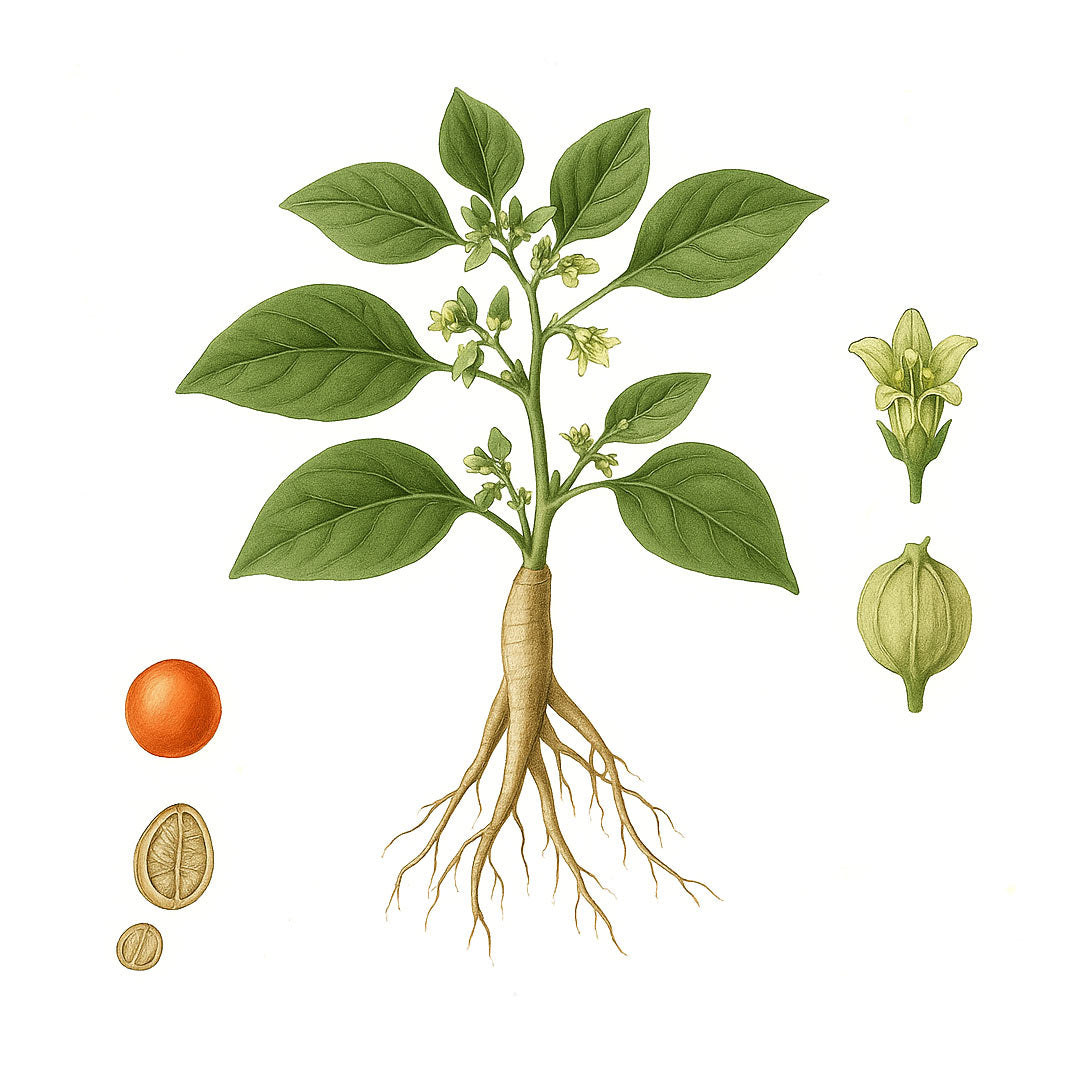
Ashwagandha
Withania somnifera
Common Name: Ashwagandha, winter cherry, withania, Indian ginseng
Arabic name: جذرالاشواغاندا
Family: Solanaceae
Parts Used: Root
Actions: Adaptogen, Sedative, Tonic, Immunomodulant, Nervine
Taste: Bitter, Pungent, Sweet
Energy: Drying, Warming
Native To: India, Africa
Geographic Distribution: India, Nepal, Pakistan, several Mediterranean countries, Middle East, Africa
Botanical Description: Ashwagandha is a shrub that grows to about 2.5-5 feet high with a central stem. The leaves are ovate and alternate. Branches extend radially and are covered in fine hairs. The flowers are green on the outside and yellow inside. The ripe fruits are smooth, orange-red berries and are inside calyxes (papery coverings). The roots are long and brown.
History and folklore: Ashwagandha translates to "that which has the smell of a horse, as it gives the vitality and sexual energy of a horse" This name alludes to the root's strong odor as well as its use to restore strength and vitality and to improve and enhance sexual drive. In the ayurvedic tradition, Ashwagandha is most commonly taken as a powder mixed into milk, especially before bedtime.
Uses: Rather than working like an aphrodisiac, the root is believed to work gradually over time to lower stress levels that may inhibit the sex drive. Ashwagandha may also support fertility. Its nervine and adaptogenic actions make it a good choice for those with anxiety, stress, insomnia and lack of energy.
Safety: It should be used with caution by those taking thyroid hormones and should not be taken by those with hyperthyroid disease. It may be useful for hypothyroidism, but should be taken under the care of a qualified health practitioner.
Some cultures use Ashwagandha as a tonic during pregnancy, but other cultures use it as an abortifacient. This effect may depend on amounts, parts used, and preparation. Those interested in using Ashwagandha during pregnancy are advised to consult with an herbalist who has experience working with this herb during pregnancy. Avoid in cases of hemochromatosis and hyperthyroidism or if taking thyroid hormones.
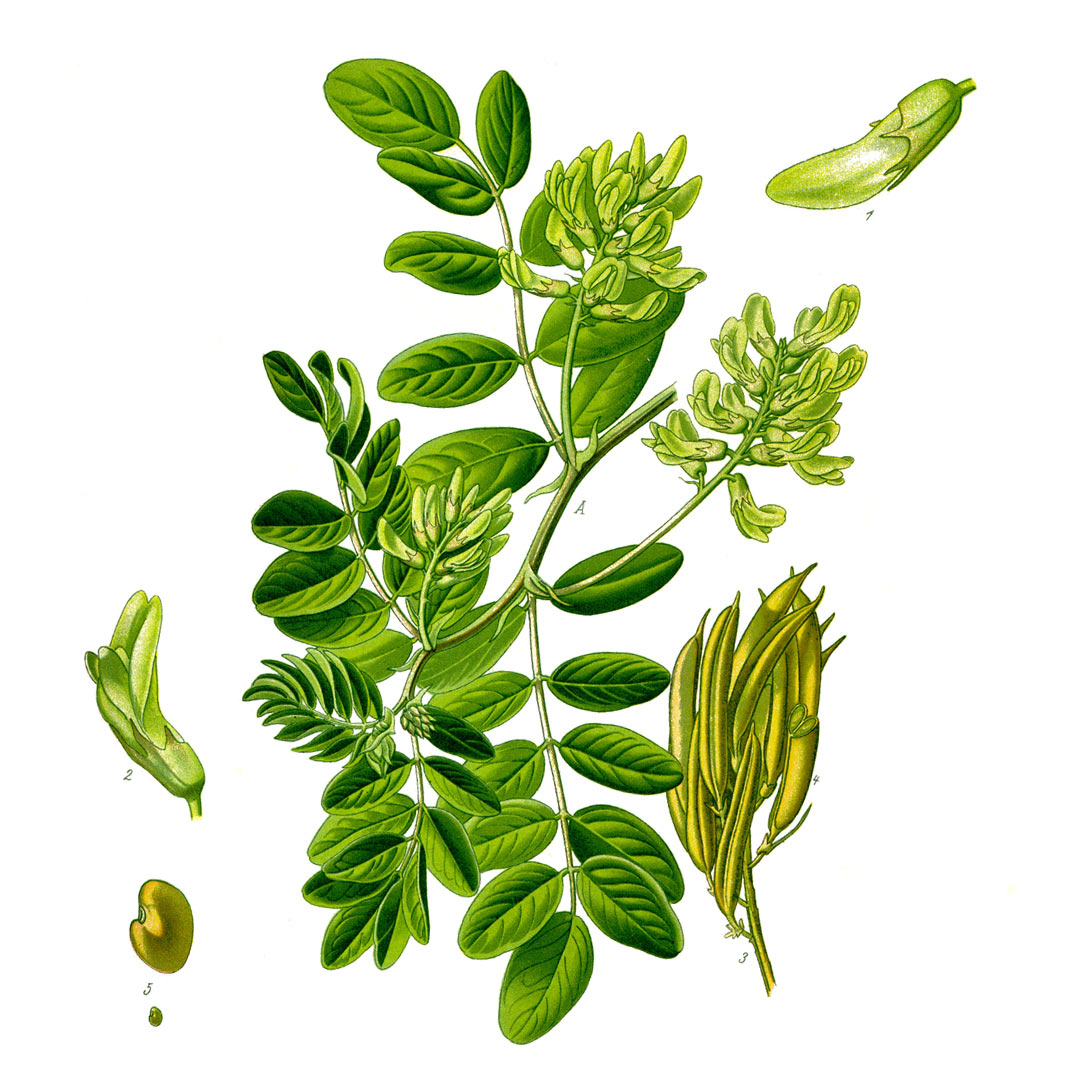
Astragalus root
Astragalus mongholicus
Common Name: Astragalus, milk vetch
Arabic name: جذرالقتاد
TCM Name: Huang qi
Family: Fabaceae (Leguminosae)
Parts Used: Root
Actions: Adaptogen, Anti-diabetic, Anti-inflammatory, Antioxidant, Cardioprotective, Hepatoprotective, Hypoglycemic, Immunomodulant, Neuroprotective, Restorative, Tonic
Taste: Slightly sweet
Energy: Warming
Native To: China, Mongolia, Korea, and Siberia
Geographic Distribution: Temperate regions throughout the world
Botanical Description: Astragalus is an herbaceous perennial that grows from 1-2 feet tall and has multiple stems. The pinnately compound bright green leaves are comprised of 12-18 pairs of pointed leaflets. Yellow pea-like flowers arranged in long clusters bloom in summer. The tough and fibrous roots are brown with a yellow core.
History and folklore: Astragalus has been used for at least 2,000 years in Chinese medicine. It was recorded in the Shennong Ben Cao Jing (The Divine Farmer’s Materia Medica), one of the first books on Chinese medicine. The Chinese Pinyin name is huang qi, which means "yellow leader", referring both to its colour and its important status in Chinese medicine. Astragalus is considered one of the 50 fundamental herbs of Chinese medicine and is an important tonic herb for maintaining vitality (qi) and strengthening resistance (immunity). Astragalus is used in broth, soups, decoctions, and infusions, and is commonly added when cooking rice, but as it is too fibrous to chew, it is removed prior to serving. Herbalists commonly add two to four root slices to a pot of soup.
Uses: Due to its slow-acting, building nature, it is best when consumed long term, for at least 3-6 months. Chinese herbalists use it for those suffering from frequent colds and flus, shortness of breath, and spontaneous sweating. As a Spleen qi tonic, Astragalus strengthens digestion and dries excess dampness in the spleen, which can manifest in issues such as nausea, vomiting, bloating, a feeling of heaviness in the body or limbs, and a tongue coating that is thick and greasy. As a general qi tonic, Astragalus is valued as a restorative for reducing fatigue. Astragalus promotes long-term strengthening of the immune system and protects against infection. Herbalist Guido Masé suggests taking Astragalus regularly in the fall and winter to strengthen immunity and keep colds, flu and bronchitis at bay. Due to its immune-modulation activity, Astragalus has been useful for bolstering against allergies and related headaches as well as for general states of autoimmune hyperreactivity. Astragalus is an adaptogen and increases the body’s ability to resist and cope with stress. Astragalus root has also traditionally been used in China for diabetes and is currently the most frequently used antidiabetic herb. Its hypoglycemic action is used to help lower blood sugar levels in people with diabetes. In traditional use, Astragalus is valued for its hepatoprotective effect, which means it protects the liver against toxic substances and viruses and supports liver health. For those experiencing chronic immune suppression, Astragalus may improve wound resolution and support the regeneration of tissue such as skin, bones, or other connective tissues. It is considered to be cardioprotective and is used for mild congestive heart failure and angina.
Safety: Astragalus mongholicus is considered safe, and no toxicity has been shown for daily use of the herb. Astragalus may be incompatible with immunosuppressive drugs and is contraindicated for patients with late-stage Lyme disease, as it may exacerbate the autoimmune response.
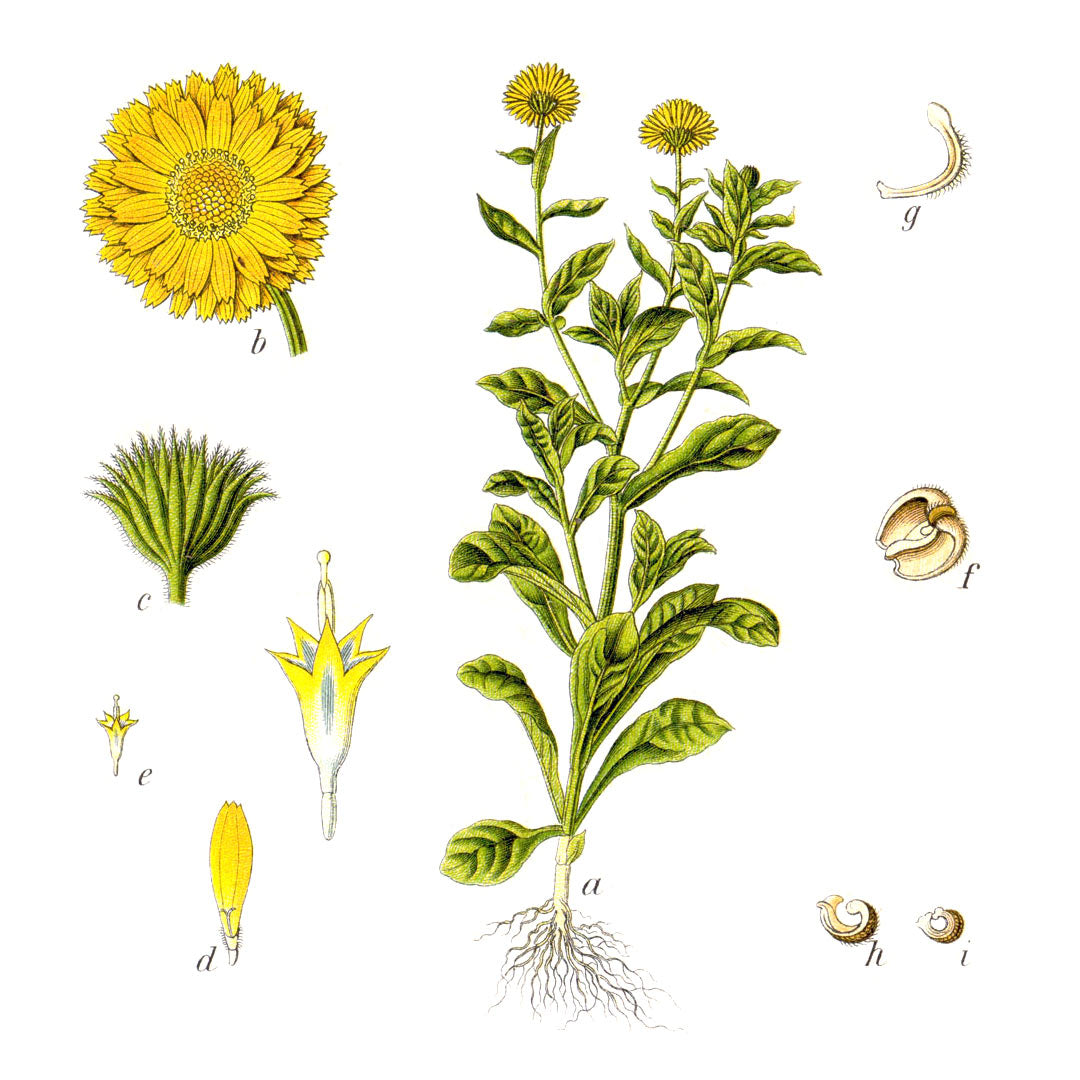
Calendula
Calendula officinalis
Common Name: Calendula, bride of the sun, bull flower, butterwort, common marigold, drunkard, English marigold, field marigold, garden marigold, golding, gold bloom, golds, gowlan, hen and chickens, holligold, husbandman’s dial, mally gowl, marigold, marybud, marygold, mary’s gold, poet’s marigold, poor man’s saffron, pot marigold, prophetic marigold, ringflower, ruddes, ruddles, Scotch marigold, Scottish marigold, summer’s bride, sunflower, throughout-the-months
Arabic name: اذريون
TCM Name: Jin zhan ju
Family: Asteraceae/Compositae
Parts Used: Flower
Actions: Anti-inflammatory, Antibacterial, Anti-fungal, Antimicrobial, Antispasmodic, Antiviral, Astringent, Cholagogue, Demulcent, Diaphoretic, Emmenagogue, Hepatic, Immune tonic, Lymphatic, Vulnerary
Taste: Bitter (mild), Sweet, Pungent, Salty
Energy: Warming, Drying, Neutral
Native To: Calendula’s primary origin is uncertain but has been suggested as North Africa, Southern Europe, and/or the Mediterranean
Geographic Distribution: Calendula is widely cultivated and has naturalized in temperate climates throughout the world.
Botanical Description: Calendula is a short-lived perennial that is often grown as an annual. The plant has a sticky texture due to its resin content. Calendula reaches up to 24 inches in height, its stalk supporting many branching stems and oblong leaves that are 3-6 inches long. Calendula has sunny yellow and orange flowers that open in the morning when the sun rises and close as it sets. The orange or yellow flower heads are 1-3 inches across and have a central cluster of tubular flowers surrounded by several rows of ray florets.
History and folklore: The name Calendula is a diminutive Latin form of calends (or kalends), meaning "the first day of each month" in the ancient Roman calendar, presumably because the flower was noted as blooming at that time or throughout each month. Today in Italy the plant is commonly known as Fiore d’ogni mese and in France as Fleur de tous les mois, meaning "flower of every month". From the 12th to the 17th centuries, Calendula also appears to possess a reputation as a mood enhancer. Some editions of De Viribus Herbarum, an herbal poem by Macer Floridus (thought to be a pseudonym of the 12th-century French physician Odo de Meung), suggest Calendula for cheerfulness, and propose that just gazing at the flower could draw away evil humors from the head. In the early 17th century, herbalist and botanist John Parkinson recorded that Calendula was of great use among pot herbs, used in food as well as in syrup or a conserve made from fresh flowers, as a "comforter of the heart and spirits, and to expel any malignant or pestilential quality, gathered near thereunto". Contemporary herbalist Matthew Wood also records an indication for heavy depression.
Uses: Calendula’s anti-inflammatory and astringent actions combined with its antibacterial, antiviral, and antifungal properties make it a great choice for a wide variety of skin issues. Calendula’s anti-inflammatory action goes a bit deeper than its indication for external skin and wound issues, however. According to research, the herb may also address inflammation related to bone and joint diseases. Calendula is known as "herbal sunshine" and is suited for places where "the sun doesn't shine", such as the glands under the neck, axilla, the breasts, groin and so forth. It is in fact commonly used as a lymphagogue: it cleanses the lymphatic system by moving the fluid, removing toxins from the lymph, and decongesting swollen lymph nodes. While much remains to be understood about Calendula’s diverse applications, Calendula’s gentle nature makes it a perfect ally for our skin.
Safety: There are a few safety concerns with calendula. It should not be used during pregnancy, as it has traditionally been used as an emmenagogue and is classed as a uterine stimulant. Calendula is a possible allergen for those sensitive to the Asteraceae plant family. While not yet studied in human trials, the herb may have potential for enhancing hypnotic or anxiolytic drugs and it has been shown, only in animal studies thus far, to increase sedative and hypotensive effects; therefore, it may potentially interact with drugs or agents with these actions as well as those with hypoglycemic or cholesterol-lowering actions. Another concern with Calendula relates to its prominent use as a vulnerary; herbalists report that wounds must be fully clean before application because they have observed that the herb rapidly repairs tissue.
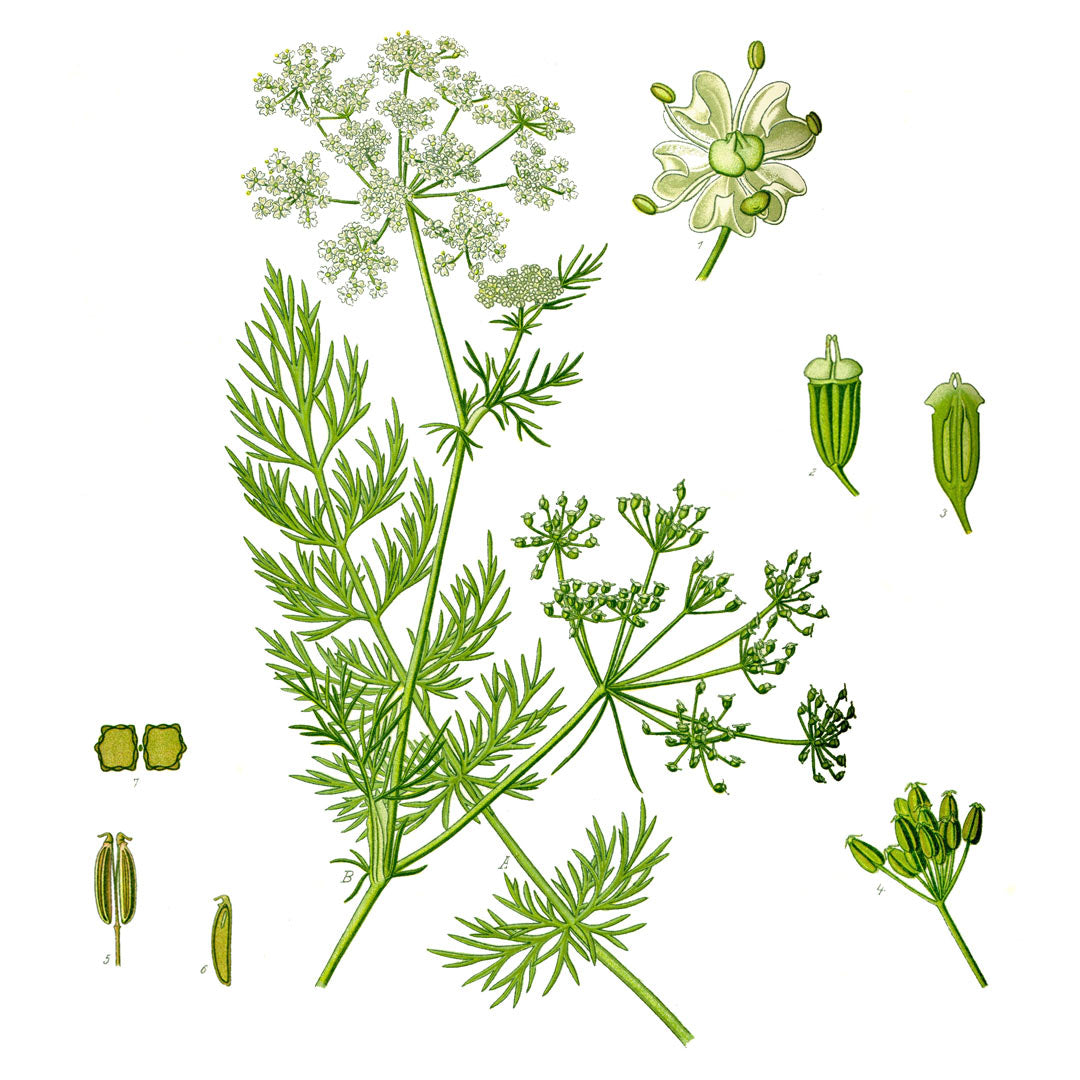
Caraway
Carum carvi
Common Name: Caraway, Persian cumin, meridian fennel
Arabic name: كراويه
Ayurvedic name: Jiraa
TCM Name: Jin zhan ju
Family: Apiaceae
Parts Used: Fruit (commonly called seed)
Actions: Antimicrobial, Antioxidant, Antispasmodic, Astringent, Bitter, Carminative, Emmenagogue, Expectorant, Galactagogue
Taste: Pungent, slightly bitter
Energy: Warming
Native To: Extends from Spain, but not Portugal, and across Eurasia to western China and most of Russia.
Geographic Distribution: Caraway has been introduced to North America, including the northern United States, some midwestern states, and a handful of southern states, as well as much of Canada. Caraway has also been introduced to Greenland, North Africa, and parts of Europe in which it is not native, including Great Britain, Iceland, and Ireland. It can be found growing in fields, meadows and along roadsides.
Botanical Description: Caraway is a biennial herb (Britannica, 2020) that grows to about 70 in (178 cm) tall. Caraway is in flower during the summer months, with the seeds ripening in late summer. Caraway has compound umbels of small, white-to-pinkish flowers. What are commonly termed caraway "seeds" are actually the whole dried fruits of the plant, called mericarps. The fruit is light to dark brown, 0.2 in (0.5 cm) long.
History and folklore: Greek physician and botanist Dioscorides named caraway Carum based on the ancient district of Caria in which it was grown; the Romans referred to caraway as carvi, hence the Latin name Carum carvi. Caraway has a long history of use as a culinary seasoning. In fact, it is believed that caraway may have been consumed and cultivated in Europe longer than any other spice. Caraway seeds have been found fossilized in ancient European areas, dating back about 8,000 years. There is documentation of caraway cultivation dating back to the Middle Ages from Sicily to Scandinavia. Caraway was used in ancient Greek recipes and was indicated by Dioscorides for various health benefits. Today, caraway continues to have diverse culinary uses and is often used in sauerkraut, breads, cakes, salad, pickles, meats, and certain cheeses and liqueurs; caraway pudding is a special dessert enjoyed during Ramadan. Caraway is the main ingredient in "Meghli", a pudding served to breastfeeding women in Lebanon and Syria to promote milk production.
Uses: Caraway is most commonly used for digestive support. Along with increasing digestive secretions, Caraway is considered to reduce inflammation in the gastrointestinal tract. The antispasmodic and carminative properties of caraway make it helpful for stimulating function of the upper and lower gastrointestinal tract, while simultaneously relaxing spasms. In Ayurveda, Caraway is considered to decrease kapha and vata, and increase pitta dosha. Caraway is often taken before meals alongside other carminative herbs, such as ginger (Zingiber officinale) and cardamom (Elettaria cardamomum), to strengthen sluggish digestion, increase thoroughness of digestion, and reduce gas. In the ayurvedic tradition, caraway is regarded as having synergistic effects when used in combination with other plants, as it is believed to improve the absorption of herbs. Due to its ability to improve digestion and soothe stomach upset, Caraway is a popular weight loss aid in the Middle East; this current use aligns with descriptions of use in the traditional Persian-Islamic text, the Makhazan Al-Advieh. Herbalist Matthew Wood mentions that caraway has an affinity for digestion of fatty foods and lipid metabolism due to its volatile oil and fixed oil content.
Safety: No clinical safety data regarding Carum carvi exists, yet due to its long history of use as a food it is generally regarded as safe. There have been cases of cross-allergy to plants in the Apiaceae family, so caution is advised for individuals with known sensitivities or allergies to coriander (Coriandrum sativum), dill (Anethum graveolens), or other plants in this family. There is some evidence based on animal studies that Caraway may modify glucose regulation, so those with diabetes are advised to consult with their healthcare provider before using this herb and monitor blood sugar levels closely.
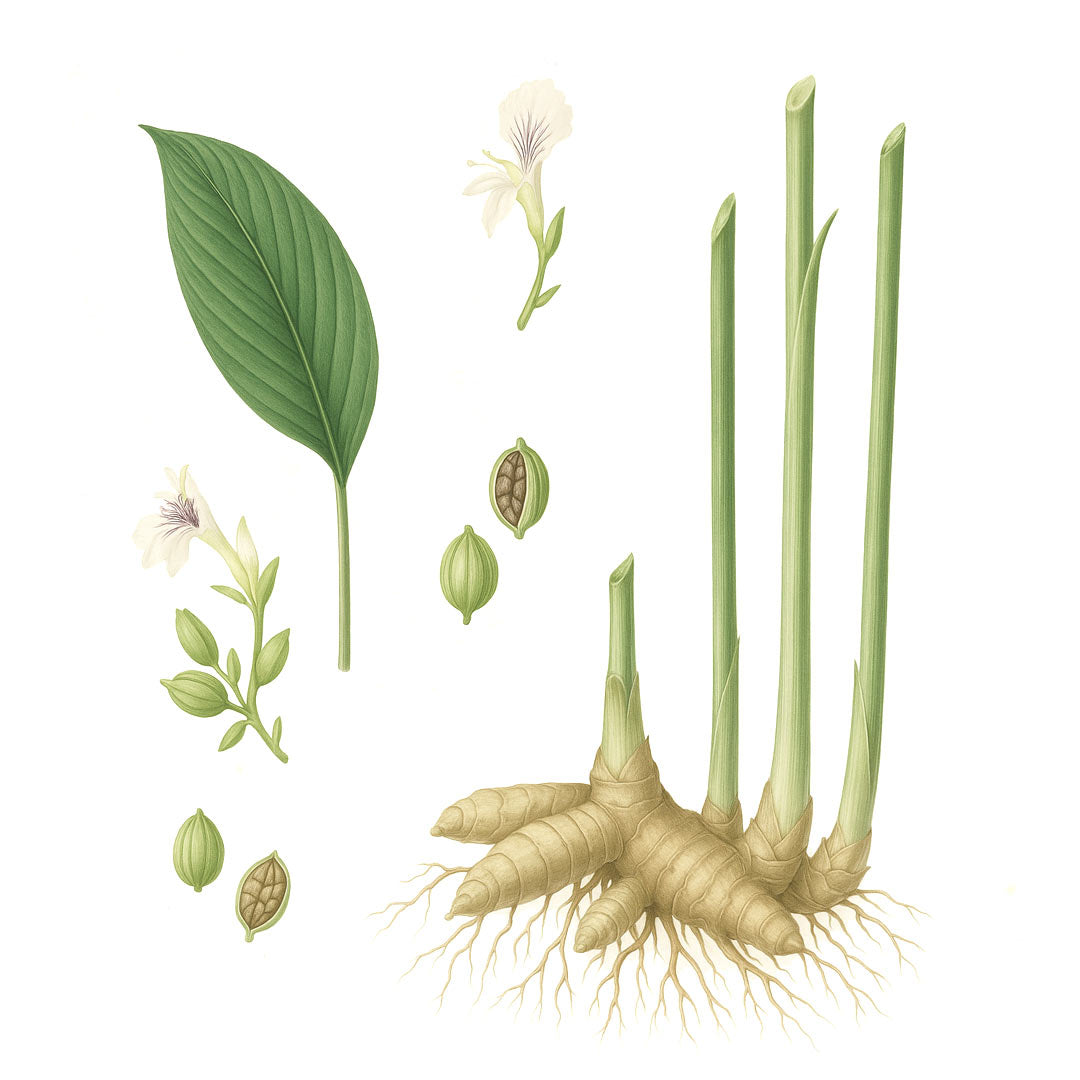
Cardamom
Elettaria cardamomum
Common Name: Cardamom
Arabic name: حب الهال
Ayurvedic name: Ela (Sanskrit), Elaichi (Hindi)
Family: Zingiberaceae
Parts Used: Seeds, seed pod
Actions: Antibacterial, Anti-nausea, Anti-catarrhal, Anti-fungal, Antioxidant, Aromatic, Carminative, Cholagogue, Circulatory Stimulant, Decongestant, Diaphoretic, Diuretic, Expectorant
Taste: Pungent, Sweet
Energy: Cool, Light, Dry, Hot, Warm
Native To: Southern India, Burma, Sri Lanka
Geographic Distribution: India, Burma, Sri Lanka, Tanzania, Vietnam, Indonesia, Nepal, Guatemala, Costa Rica, Mexico
Botanical Description: An herbaceous perennial reaching 2-5 meters tall, cardamom has clumps of bundled leaves that emerge from underground rhizomes, which are the true stems. The irregular flowers feature a single white petal-like labellum (about 1.8 cm long) with pink streaks on the central lip. The ovary matures into an ellipsoid, fleshy capsule that begins green, then turns golden yellow when fully ripe and contains about 15-30 seeds.
History and folklore: Cardamom has a long history of use. It is referred to in a clay tablet in ancient Sumeria, around 2000 BC. Described in 3rd century BCE Ayurvedic literature and in ancient Greek and Roman medical texts, and was celebrated throughout The Arabian Nights, which was compiled during the Islamic Golden Age. Cardamom was known as khair buwwa by ancient Persian physician Ibn Sina, and noted it as beneficial for stomach and ‘cold’ liver.
Uses: By promoting downward movement in the gastrointestinal (GI) tract, cardamom may be helpful for digestive complaints with an upward-moving motion, such as burping, acid reflux, nausea, vomiting or morning sickness. It also has been compounded in antispasmodic formulas for gut cramping, spasms or irritable bowel problems. Cardamom may benefit those experiencing nausea that contributes to a lack of appetite. Herbalists appreciate cardamom’s ability to soothe nervous digestive problems stemming from a lack of secretion caused by excess sympathetic stress, as Cardamom supports the parasympathetic state. A gentle herb with a delightful flavour, cardamom can be supportive for children’s digestion and can help to ease stomach aches. Cardamom may also have antimicrobial action against Helicobacter pylori, and has been utilized as a mild-moderate antibacterial and antiviral in the digestive tract. With the reputation for "opening the body’s energy or prana" flow, as well as classical Vedic depictions as a vajikarana, loosely translated as "aphrodisiac" but also referring to deep vitality, cardamom has been renowned for its ability to allow energy to move freely through the body to be harnessed.
Safety: No drug-herb interactions are reported. Both Western and Ayurvedic practitioners recommend avoiding intake when a person shows strong signs of heat. If consumed in excess, Cardamom may overstimulate upper gastrointestinal secretions. Avoid use beyond mild culinary applications in those with blocked bile ducts, due to Cardamom’s cholagogue activity. There have been case reports of contact and systemic contact-type dermatitis reactions to Cardamom, confirmed by patch testing.
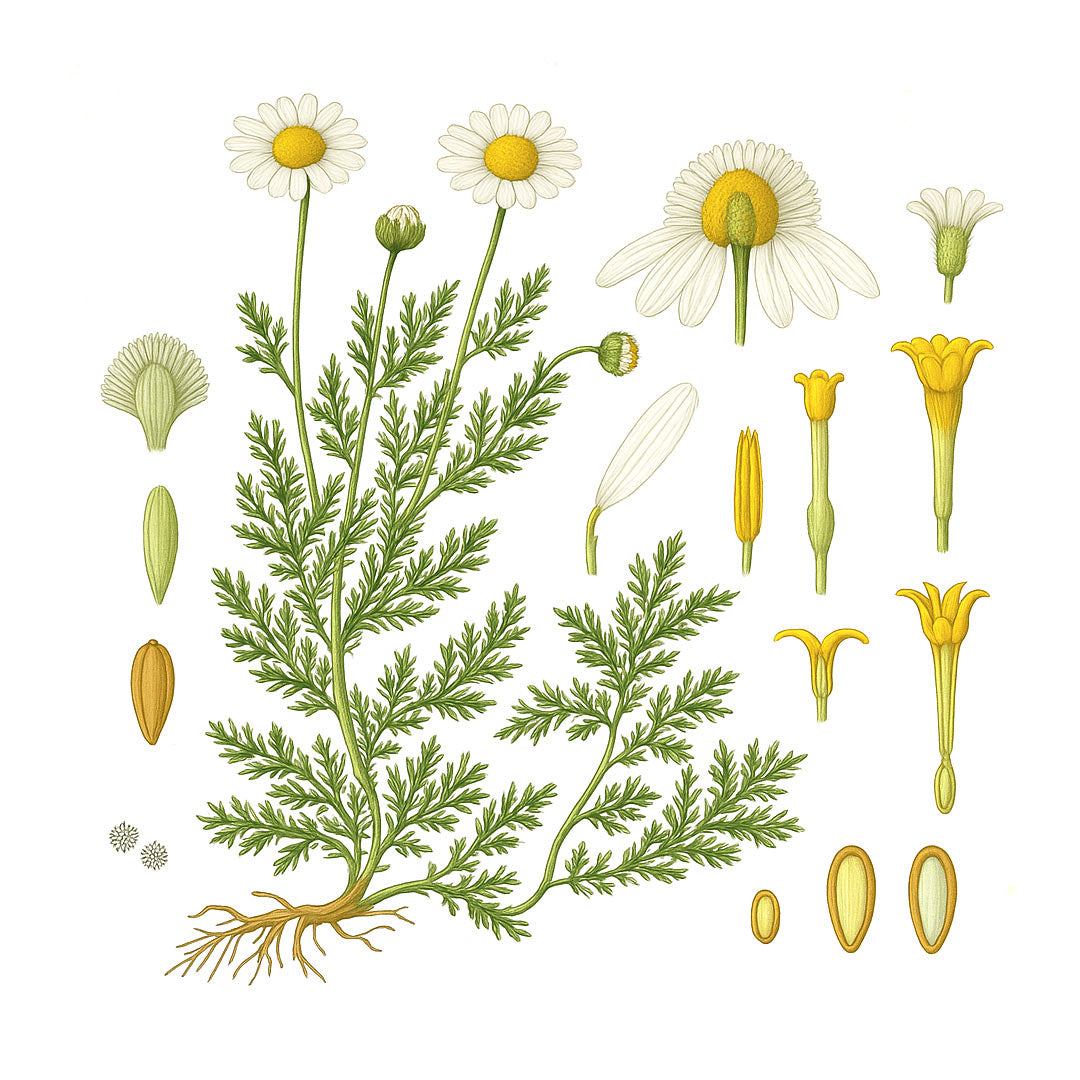
Chamomile
Matricaria chamomilla
Common Name: Chamomile, camomile, German chamomile, Hungarian chamomile, manzanilla, scented mayweed, sweet false chamomile, true chamomile, wild chamomile
Arabic name: بابونج
Family: Asteraceae
Parts Used: Flower head
Actions: Anti-inflammatory, Antispasmodic, Anxiolytic, Bitter, Carminative, Nervine, Sedative, Vulnerary
Taste: Bitter, Sweet
Energy: Cooling, Drying
Native To: Southern and Eastern Europe
Geographic Distribution: Asia, Australia, Europe, India, New Zealand, North America, and South America
Botanical Description: German chamomile is an herbaceous annual with delicate, feathery, mild aromatic leaves in fine filiform segments growing from a smooth, branching stem that typically grows between 12-24 inches (30-60 cm) in height. The composite aromatic flowers measure between 0.4-0.8 inches (1-2 cm), arise from the apices on each individual stalk as a single flower, and feature white ray petals surrounding a yellow disk of tubular florets in the centre. The main characteristic to tell German chamomile apart from similar-looking species is the hollow conical receptacle, which can be seen by splitting the flower head through the middle. Interestingly, its essential oil is blue.
History and folklore: The name Chamomile is derived from the Greek khamaimēlon meaning "ground apple," alluding to the apple-like scent of the plant. The Latin genus name Matricaria comes from "matrix", meaning uterus, which is derived from mater, the word for mother. Historically, people in several European countries referred to Chamomile as "mother herb", because of its application during childbirth and postnatal care. Chamomile was also known as "maiden flower", believed to refer to the Greek physician Dioscorides who suggested the herb, amongst other indications, for menstrual health. Chamomile has been used since at least the 1st century CE for digestive problems, but its use predates written history, Chamomile, along with yarrow (Achillea millefolium), was found in scrapings from 50,000-year-old Neanderthal teeth discovered in northern Spain. Culpeper (1643/1850) writes that in ancient Egypt, the herb was dedicated to the sun. Chamomile comforts all parts of the body that need warmth, he writes, and bathing in a chamomile bath eases pains and aches and reduces swellings.
Uses: Chamomile may appear wispy and gentle, but it is a powerful nervine and potent anti-inflammatory and one of the most versatile plants in the herbal apothecary, whether in clinical practice or in the home. Chamomile is used for minor gastrointestinal complaints including bloating and spasms. Chamomile is also suggested to soothe colds, minor ulcers, and inflammations of the mouth and throat, and topically applied to ease irritations and minor inflammations of the skin, such as sunburn and superficial wounds. Herbalists value the aromatic herb for its sedative, antispasmodic, and anti-inflammatory actions, as well as its calming and soothing effects on the gastrointestinal tract. Chamomile’s antispasmodic action is also employed for menstrual cramps and its soothing effects as a nervine may also ease other symptoms of premenstrual syndrome (PMS), such as nervousness. As an anti-inflammatory herb, Chamomile can be used topically for skin irritations such as rashes, abrasions, and insect bites and stings.
Safety: Chamomile is generally considered safe when taken within the suggested dose and is a gentle herb suitable for children, and during pregnancy and lactation; however, safety studies are limited and several contraindications need to be taken into consideration. Chamomile can cause allergic reactions in some individuals, especially those who are sensitive to plants in the Asteraceae family.
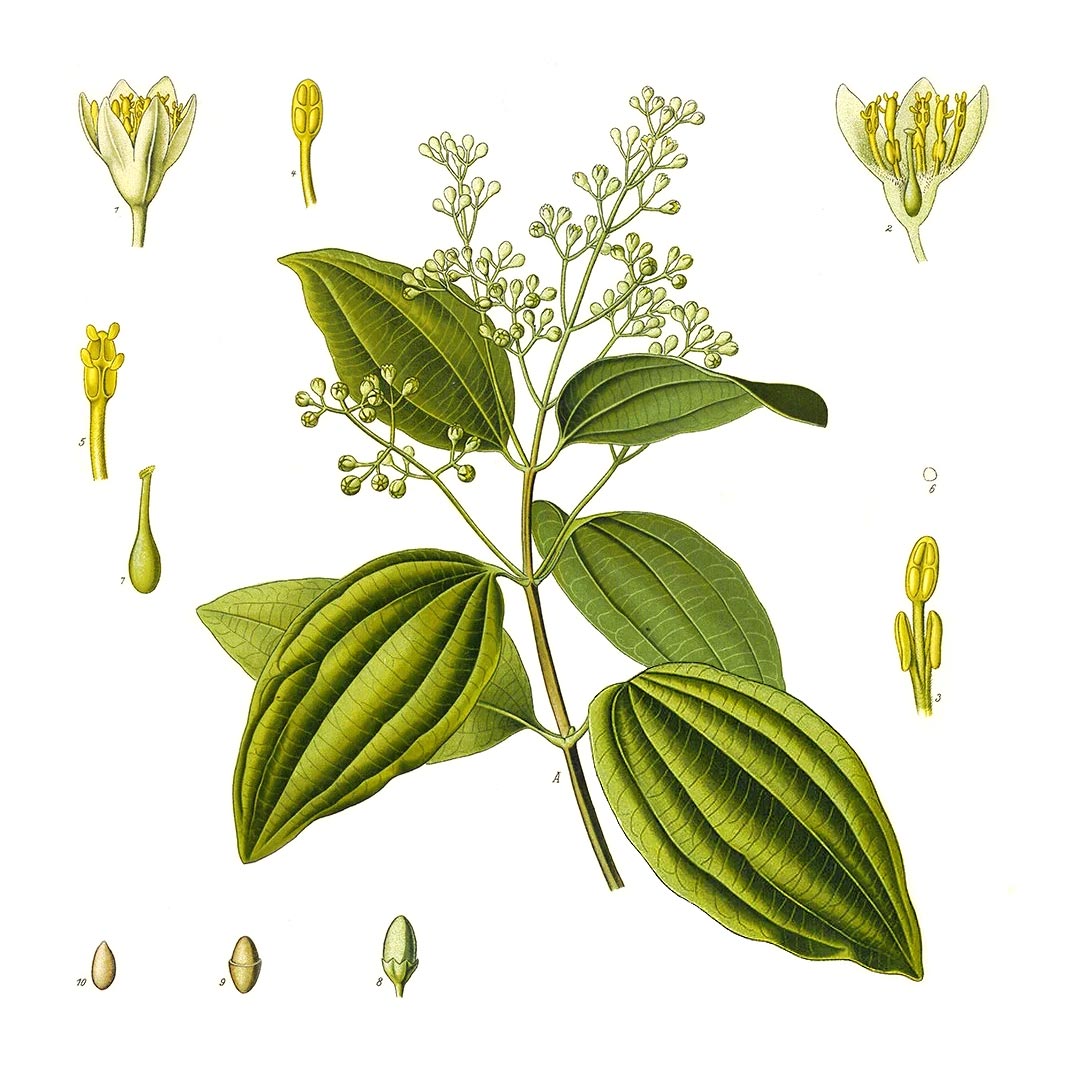
Cinnamon
Cinnamomum zeylanicum
Common Name: Ceylon cinnamon, cinnamon
Arabic name: عود القرفة
TCM name: Cassia
Ayurvedic name: Tvak
Family: Lauraceae
Parts Used: Bark
Actions: Antibacterial, Antifungal, Anti-inflammatory, Antioxidant, Astringent, Carminative, Circulatory Stimulant
Taste: Aromatic, Sweet, Pungent
Energy: Warming, Drying
Native To: Sri Lanka, Southern India
Geographic Distribution: Sri Lanka, southern India, Southeast Asia, Central America, Madagascar, and Africa
Botanical Description: Cinnamon was not cultivated until 1776. The plant originally grew in tropical forests on the island of Sri Lanka in a wild state. However, the bulk of the bark gathered today comes from cultivated plants. The plant is a tropical evergreen tree that grows to 26-59 feet (8-18 meters); the pruned shrub has soft reddish, aromatic brown bark, and clusters of yellow flowers. Today the plant is widely cultivated in the tropics.
History and folklore: Cinnamon bark has been used for several thousand years in traditional Eastern and Western herbalism. Traditionally used for warming in energetically cold conditions and for digestive complaints, cinnamon has been used in Egypt from 2000 BCE and parts of Europe from 500 BCE.
Uses: Herbalists employ cinnamon’s astringent (toning) action to control excess menstrual flow and postpartum bleeding. However, more research is recommended to study the efficacy of cinnamon on reducing menstrual bleeding. Cinnamon is also used as a circulatory stimulant to encourage peripheral blood flow to the hands and feet. As a digestive stimulant and carminative, cinnamon bark is also used for bloating, dyspepsia, nausea, flatulent colic, and spastic conditions of the gastrointestinal tract. In addition, cinnamon is employed for head and skin infections and to ease depression.
Safety: Cinnamon may provoke allergic or sensitization reactions of the skin or mucous membranes. Avoid larger doses during pregnancy except under the supervision of a healthcare practitioner; its safety during lactation has not been determined.
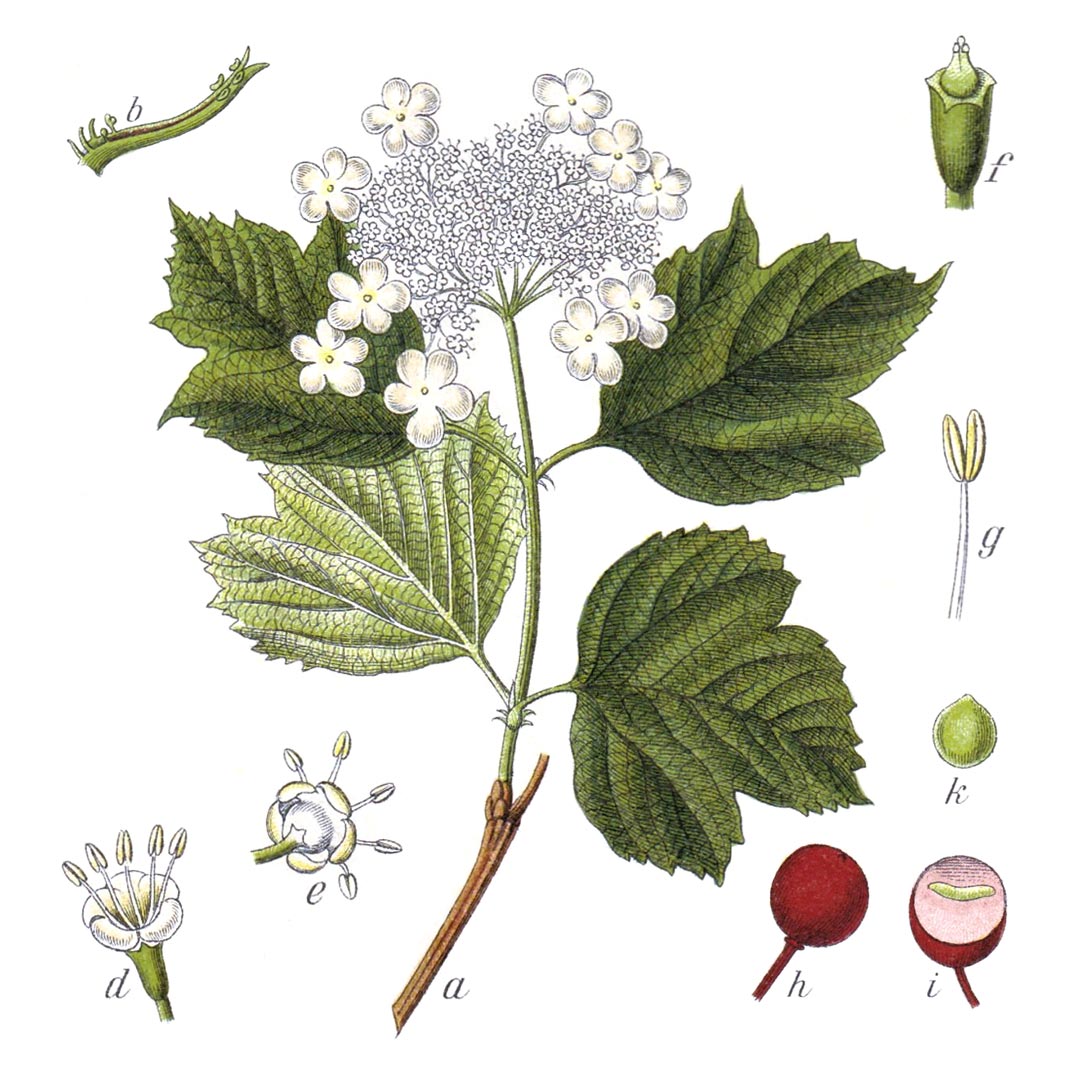
Cramp bark
Viburnum opulus
Common Name: Cramp bark, guelder rose, king’s crown, red elder, rose elder, water elder, highbush cranberry, cranberry tree, European cranberry bush, snowball tree, whitsun rose, dog rowan tree, silver bells, whitsun bosses, gaitre berries, black haw
Arabic name: لحاء الرباطية درهمية الأزهار
Family: Adoxaceae (formerly Caprifoliaceae)
Parts Used: Bark
Actions: Anti-abortive, Antispasmodic, Astringent, Diuretic, Emmenagogue, Nervine, Sedative, Tonic
Taste: Bitter, Acrid
Energy: Cooling, Drying
Native To: Europe, Northern Africa, Northern Asia
Geographic Distribution: Cramp bark grows throughout Europe, as well as in Northern Africa and Northern Asia. It has naturalized in North America
Botanical Description: Cramp bark is a deciduous shrub that grows from 3 to 12 feet tall and up to 15 feet wide. It has palmate, three-lobed leaves that are coarsely toothed. In late spring, it bears attractive white flowers that can grow in umbels up to five inches wide. In August, cramp bark’s bright red fruit hangs in heavy, translucent clusters. Though edible, the fruits are bitter, so much so, that the birds often leave them uneaten throughout the whole of winter.
History and folklore: Medicinally, the Iroquois used the berries for liver and blood conditions, while records show the Micmac, Penobscot, and Malecite people used the bark for swollen glands, and related conditions, including the mumps.
Uses: Cramp bark contains valerianic acid, which is a powerful parasympathetic relaxant known to soothe smooth muscle cramps. It’s list of uses is impressively long. Cramp bark has been used to address nervous tension and the acute spasms associated with bronchitis, asthma, and whooping cough. It is also considered useful for heart palpitations, high blood pressure, and for controlling an irregular pulse, as well as for intestinal cramping, enteritis, colitis, and dysentery. Cramp bark can soothe cystitis, enuresis, and the spasmodic stricture of urinary tract infections and is a boon for women suffering with menstrual cramps and with the pains during or after labour. Cramp bark is used to soothe lower back pain and can be used for arthritic joints made rigid from constant contracting. Topically, cramp bark lotion can be used to relax muscles and restore blood flow to injured joints and the surrounding tissues and thus is used as an alternative to ibuprofen and other oral anti-inflammatories.
Safety: Cramp bark may cause gastroenteritis and hypotension. Individuals with blood disorders, those taking blood thinners, people with a history of kidney stones, or those allergic to aspirin should not use cramp bark. During pregnancy, cramp bark should only be used under supervision of a trained practitioner.
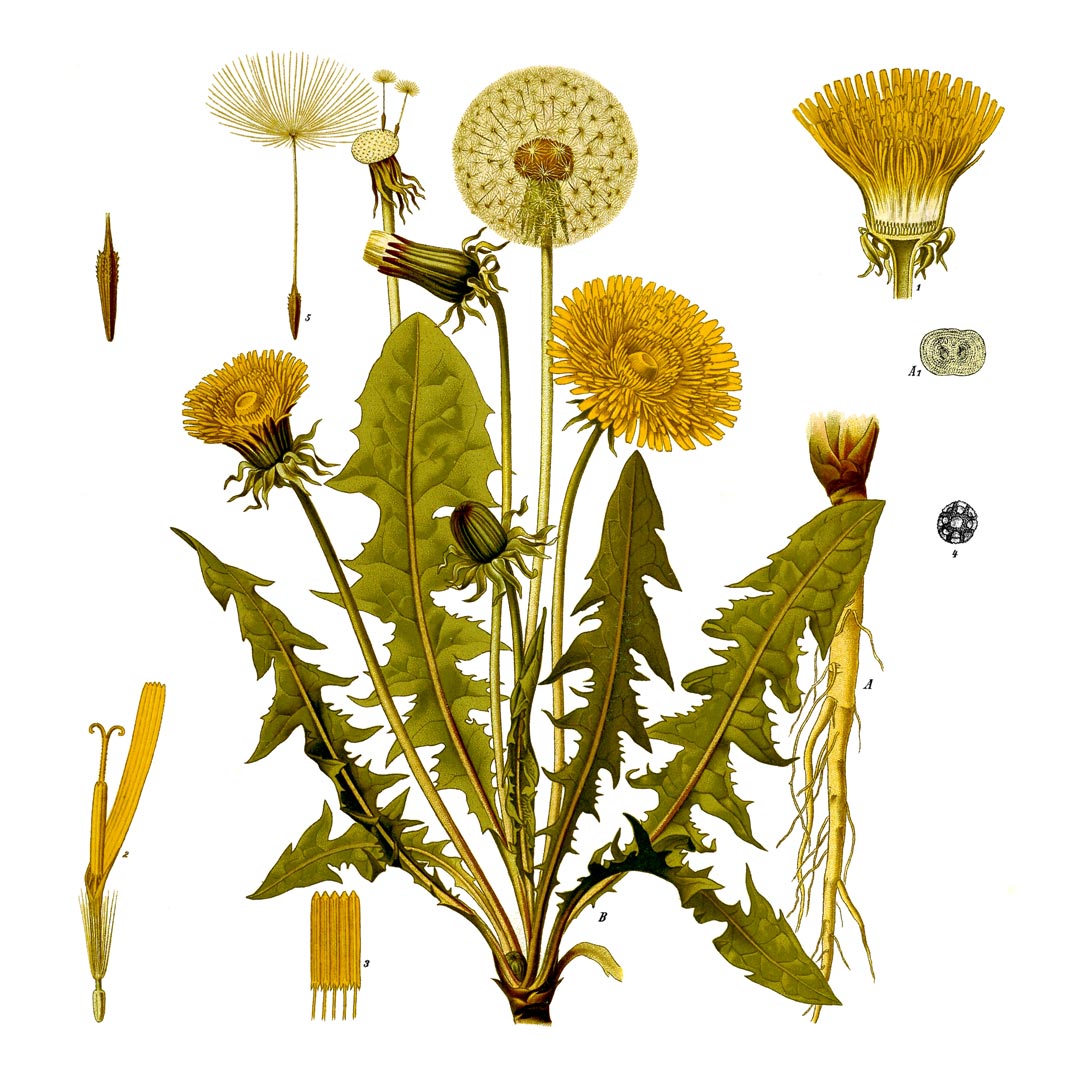
Dandelion root
Taraxacum officinale
Common Name: Dandelion, blowball, cankerwort, Irish daisy, monk’s head, priest’s crown, swine snout, wild endive, witch gowan, and yellow gowan
Arabic name: الهندباء
TCM name: Pu gong ying
Ayurvedic name: Simhadanti
Family: Asteraceae
Parts Used: Entire plant
Actions: Diuretic, Cholagogue, Bitter, Tonic, Hepatic, Alterative, Aperient, Nutritive
Taste: Bitter, slightly sweet, slightly salty leaf
Energy: Cooling, Drying
Native To: Eurasia
Geographic Distribution: North America, South America, Europe, southern Africa, New Zealand, Australia, and India
Botanical Description: Perennial with basal leaves that are spatulate to lanceolate, and deeply toothed. The stalks are hollow and leak a milky latex when broken. Each stalk holds one flower. What look like tiny petals on the yellow flower head are actually individual flowers themselves called florets. Roots are thick and unbranched.
History and folklore: The name dandelion is derived from Old French, dent-de-lion, translating as "tooth of a lion" or "lion’s teeth". Since the plant’s arrival in North America, dandelion has been an important food and herb for many Indigenous peoples of North America. For the Anishinabeg, dandelion historically served as an important source of nutrients at winter’s end when food was scarce. The Anishinabeg have also traditionally used the plant as a blood purifier for addressing skin issues. Karuk herbalist Josephine Peters mentions using dandelion for anaemia and as a diuretic for kidney and bladder issues; she also notes topical uses that include applying the fresh sap to warts and applying a wash made with the whole plant for impetigo. The Lumbee have traditionally employed dandelion leaf tea for jaundice, constipation, and kidney infections, and have also made a wine with the blossoms to boost the appetite. Dandelion has also been utilized among the Cherokee for gout and rheumatism, and as a diuretic and liver tonic. While these uses certainly attest to dandelion’s versatility, this is by no means an exhaustive list, as many Indigenous peoples have used and continue to use the plant for a wide variety of applications.
Uses: Dandelion leaf is an effective diuretic through its stimulating effect on the kidneys, encouraging proper elimination of uric acid, thus clearing out metabolic wastes. This is helpful in the case of water retention, urinary and prostate infections, gout, arthritis, and rheumatism. Dandelion’s high potassium and other mineral content offsets the resultant potassium and mineral loss through the urine. Thus, dandelion is a safe diuretic to use even in the case of water retention associated with cardiac conditions. Dandelion is an excellent mild bitter tonic to offset the sweet tastes typical for the Western diet. Bitter herbs help to stimulate appetite and activate digestion and metabolism by stimulating secretion of bile, gastric enzymes, and pancreatic enzymes. As a choleretic, dandelion root increases the amount of bile produced by the liver and gallbladder, aiding the digestion of fats. Due to its gentle improvement of bile flow, dandelion acts as a mild laxative. Herbalists celebrate dandelion as a supreme liver tonic as it excels at clearing excess heat (inflammation), clearing stagnation (congestion), and supporting detoxification of metabolic wastes. It is also considered an alterative, supporting the liver in removing metabolic wastes from the blood, which helps clear eruptive skin conditions like eczema. As Ellingwood described, dandelion "encourages the eliminative changes carried on by the liver". This includes elimination of hormones, thus providing hormonal balance during menstruation and easing the skin eruptions caused by hormonal fluctuations. The white, milky sap in the stem of dandelion is a natural latex that effectively dissolves warts when applied topically. Those with a latex allergy should proceed cautiously and do a skin patch test first.
Safety: In general, dandelion is a safe tonic herb. Dandelion is in the Asteraceae family and may rarely cause reactions in people very sensitive to other asters (ragweed, etc). Those with gallbladder or kidney issues should ask their doctor before taking dandelion. Those on blood thinners or diuretics should avoid dandelion. Dandelion is contraindicated in the case of acute gastric inflammation as it stimulates stomach acid.
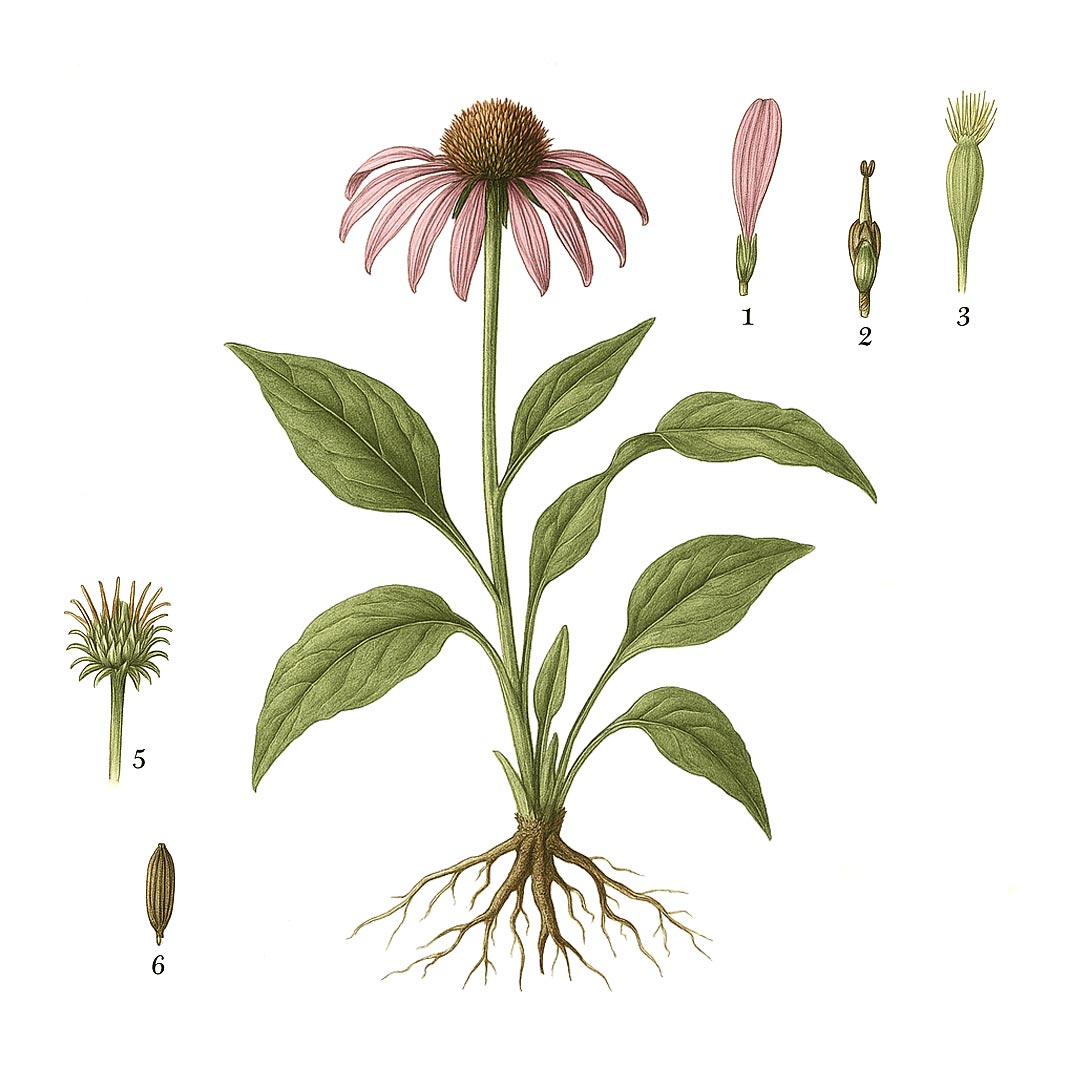
Echinacea
Echinacea angustifolia
Common Name: Echinacea, coneflower, purple coneflower, purple Kansas coneflower, comb flower, Missouri snakeroot
Arabic name: قنفذية
Family: Asteraceae
Parts Used: Roots, flower heads, leaves
Actions: Alterative, Immune Stimulant, Immunomodulant, Analgesic, Antibacterial, Antiviral, Sialagogue
Taste: Acrid
Energy: Cooling
Native To: North America
Geographic Distribution: North America, Europe
Botanical Description: A perennial that grows up to four feet in height. Most echinacea grows from a taproot. Stems are unbranched and straight. Leaves are typically hairy and alternate. Petals are usually purple arranged around a bristle-y cone-shaped seed head.
History and folklore: Echinacea comes from the Greek word echinos or "prickly, spiny" or "sea urchin" in reference to its bristly, comb-like seed head. Echinacea angustifolia is an immune stimulant and modulator traditionally used by North American plains people for at least 400 years for symptoms in the throat and mucus membranes, topically for snake and insect bites as well as burns and skin afflictions (using a mashed paste of the entire plant), dental cavities, venereal disease, gastrointestinal (GI) tract disorders, and even arthritis.
Uses: Echinacea is an excellent ally for infections and low immunity. It is an Immune Stimulant, Immunomodulant Analgesic, Antibacterial and Antiviral. The herb’s immune stimulation derives from three mechanisms:
- Activates cells that destroy foreign substances such as bacteria and repairs tissues.
- Increases respiratory activity.
- Increases mobility of white blood cells, which protect against infections.
The topical Echinacea application is highly effective in healing skin conditions including burns, eczema, inflammation, herpes simplex, and varicose veins.
Safety: An allergic reaction may be possible in people with allergies to Asteraceae family plants.
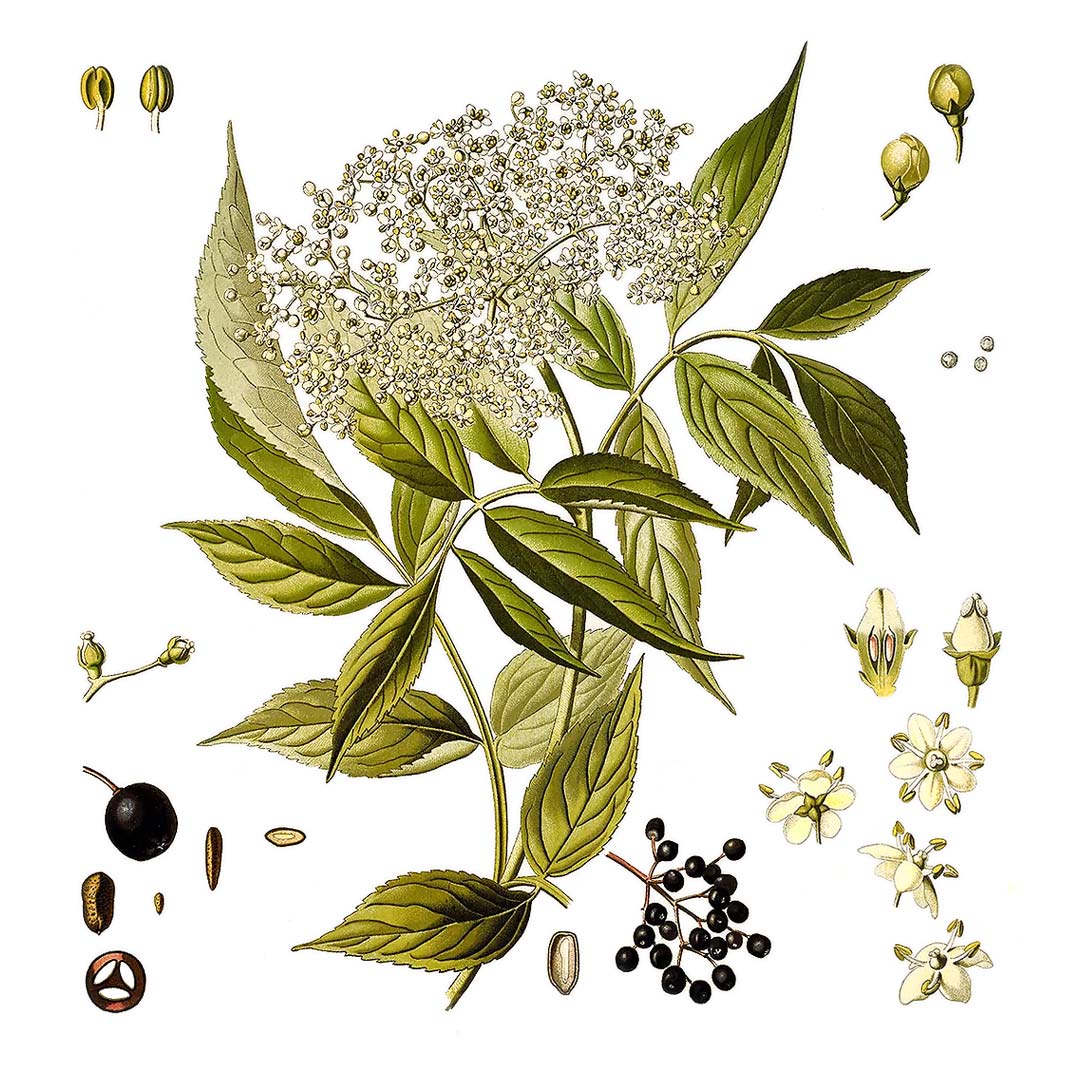
Elderberry
Sambucus nigra
Common Name: Elder, black elder, blue elderberry, bore tree, bourtree, common elder, elderberry, elkhorn, sweet elder
Arabic name: خمان أسود
TCM name: Jie gu mu
Family: Adoxaceae (formerly Caprifoliaceae)
Parts Used: Flower (dried), berry (cooked)
Actions: Diuretic, Antiviral, Analgesic, Anti-inflammatory, Antioxidant, Immune Stimulant
Taste: Slightly sweet
Energy: Cooling, Pungent
Native To: Europe and parts of Asia and Africa
Geographic Distribution: Asia, Africa, Europe, North America
Botanical Description: Elder tree grows from 10 to 30 feet tall with compound leaves comprised of 5-11 serrated oblong leaflets and extra leaflet on top. The leaves grow opposite each other along the stem, which is hollow and has a pithy core. The flowers are white arranged in flat panicles. The fruit are flat or slightly rounded branching clusters of glossy dark purple or black berries that appear in late autumn.
History and folklore: Elder is referred to time and again as “the medicine chest for the country people”, alluding to its wide-ranging medicinal actions and ready availability. Elder’s botanical name Sambucus is from the Greek musical instrument the sambuke, made from the hollow stems of elder wood, and nigra refers to its black berries. In the 4th century B.C.E., Hippocrates recommended elderberry for a wide variety of complaints. Elder has been revered as a magical and sacred plant throughout history in many cultures, and has been used to ward off evil influences, carried for good luck, and protect the home. Ancient legends from different parts of the world say that a wise woman (nymph) named Elda Mor (Hylde-Moer) lives in the elder tree to watch over it and offer healing to us, and when you seek elder’s help for healing, you must show respect for her powers and honor her. Offering gratitude for a plant’s gift of healing is always recommended as a way to connect with the plant and receive its support.
Uses: Elderberries are rich in vitamins A and C, antioxidant flavanoid compounds, and iron. Elderflower and elderberry are both exceptional allies during colds, flu, and respiratory infections due to their diaphoretic and antiviral actions. Taken as a hot tea (or tincture), elderflowers move energy and qi outward by stimulating circulation and promoting sweating, removing toxins from the body and reducing fever after its work of killing pathogens is done. Elderflower is also anti-inflammatory, anti-catarrhal and expectorant, and helps in cases of colds, sinusitis and sinus allergies to reduce inflammation of sinus tissue and allow for the movement of congestion. Elderberry is also effective for coughs and congestion associated with lower respiratory viral infections, promoting expectoration of mucus associated with bronchial infections. Elderflowers and elderberries are anti-inflammatory. The flowers and berries contain anthocyanins (pigments which impart the blue and purple color) which reduce the buildup of uric acid in the joints, so are used to reduce inflammation associated with rheumatism, gout, and arthritis. Fresh elder leaves are used externally as a poultice or an oil infusion for bruises, sprains, and wounds due to their vulnerary (tissue healing) and astringent (toning) actions. Elderflowers are also a relaxing nervine, supporting the nervous system in times of stress. The relaxing nature is also soothing to nerves, anxiety, and depression.
Safety: Elder bark, leaves, roots, seeds, and unripe berries contain alkaloids and cyanogenic glycosides, which may cause nausea, vomiting, and diarrhea as well as depression of the central nervous and respiratory systems. This reaction occurs only if these plant parts are used fresh, as cooking or drying reduces the cyanogenic glycoside content. The elderflowers are considered safe even for small children, and the ripe fresh berries are considered safe unless consumed in high quantities or by someone sensitive to the compounds in the plant; however, cooking or drying them is the safest approach. Due to its diuretic effects, use caution if taking with drugs that increase urination.
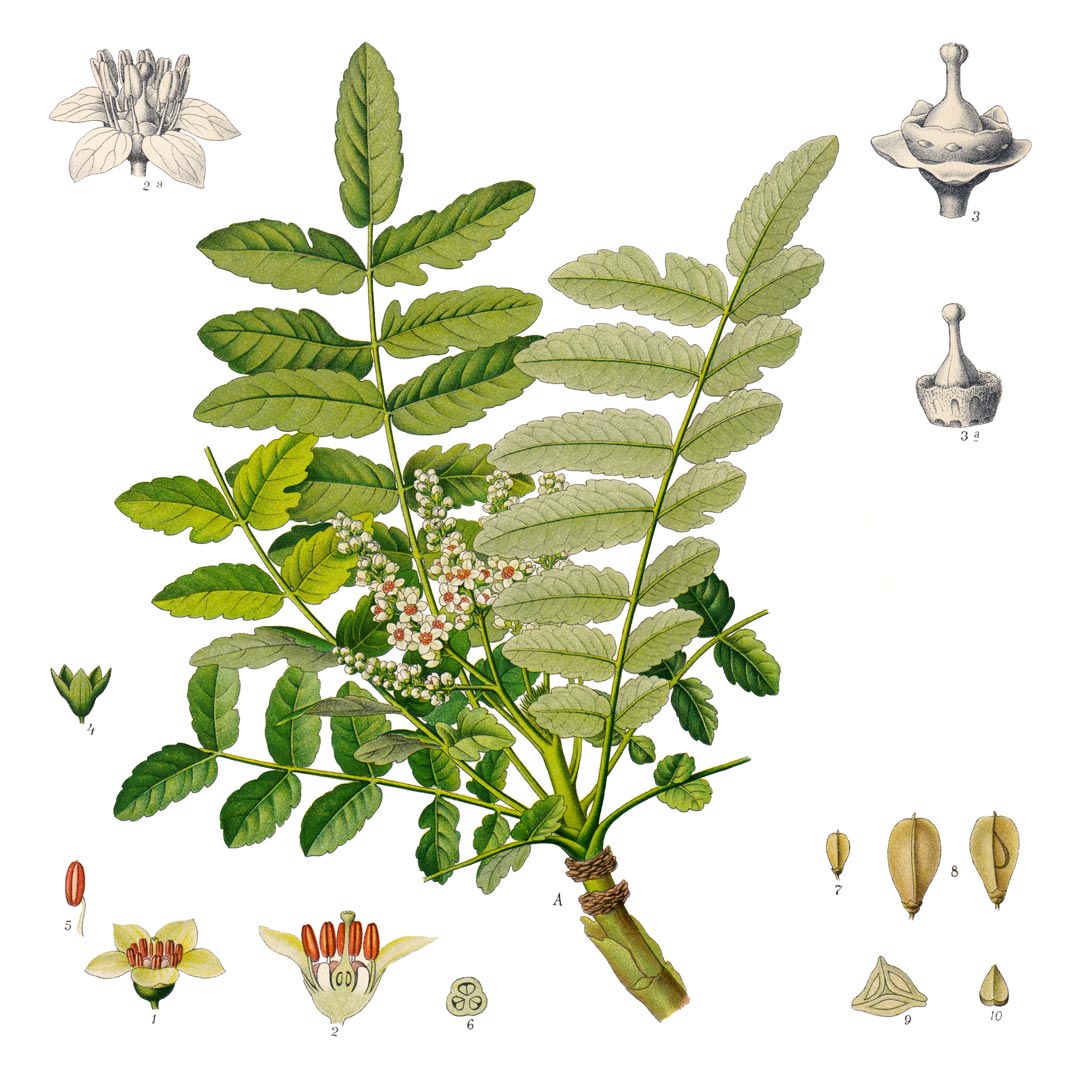
Frankincense
Sambucus nigra
Common Name: Frankincense, boswellia
Arabic name: اللبان
TCM name: Ru Xiang
Ayurvedic name: Shallaki, Semul, Simul
Family: Burseraceae
Parts Used: Resin
Actions: Analgesic, Anti-inflammatory, Stimulant, Cardiotonic, Carminative, Stomachic, Parasiticide, Diuretic, Antiseptic, Hemostatic, Anti-fungal, Hypoglycemic, Hypolipidemic, Antibacterial, Antimicrobial
Taste: Spicy, Pungent, Bitter
Energy: Warming
Native To: India, Southern Arabia, Africa
Geographic Distribution: India, Burma, and Shri Lanka and many other Eastern Himalayan Countries. It has naturalized to many tropical parts of Asia, Africa, and the Arabian peninsula. Most of the world’s supply comes from Somalia, Eritrea and Yemen, countries plagued by conflict in recent years, which has negatively affected their frankincense production. But peaceful Oman produces the world’s finest – and most expensive – frankincense.
Botanical Description: Leaves of this tree are deciduous and alternate towards the end of branches. Grows up to 18 metres in height. Leaflets are paired in about 10 sets with one terminal leaflet. They are oblong, obtuse, serrated, and pubescent. Flowers have 5 white to pale pink colored petals.
History and folklore: Used for 6,000 years as a perfume and panacea, frankincense is a very well-known Biblical herb. From the Hellenistic period onward, these resins and their lucrative westward trade became the principal reference point for Arabia in the Mediterranean world. Historically, frankincense use as an incense was far reaching. It was used in many ceremonies with other resins and is included in the Jewish compound of the four ‘sweet scents.’ It was an offering used in Babylon during the feast of Bel as well as in ancient Persia and Assyria. Traditions such as this continue today in Western India. Romans did not confine their use of this incense to ritual but also used it in the home as well. The burned remnants of this resin have also been used for makeup, being used by Egyptian women, who painted their eyelids with various resins mixed with charred frankincense.
Uses: In the Ayurvedic tradition, the resin of frankincense has anti-inflammatory effects believed to support rheumatoid arthritis, osteoarthritis, gout, joint pain, skeletal muscle pain, and back pain. The resin supports the lungs, for bronchitis and asthma, and the digestion, for diarrhoea and dysentery. Flowers have also been used for haemorrhoids and the roots contain stimulant, tonic, and aphrodisiac properties. In the nervous system the resin acts as an analgesic, mental tonic, stimulator, cardiotonic, and eye tonic. It regulates stool colour, improves digestion, is an anti-diarrhoeal, a stomachic, carminative, and anthelmintic. In the urogenital system it is a diuretic and improves menstruation. It is antipyretic and increases perspiration. Olibanum is antiseptic, wound cleaning and supports connective tissue growth and the essential oil has antifungal properties. In Traditional Chinese Medicine, Boswellia is considered to have four main energies. It is pungent for dispersing, bitter for purging, warm for promoting circulation of qi, and aromatic for moving. Frankincense supports traumatic injury by alleviating pain from stagnant blood and qi through increased circulation and removing the blood stagnation. Externally, frankincense will alleviate pain and promote wound healing. With myrrh it is commonly a gum disease mouthwash.
Safety: Should not be used by pregnant women.
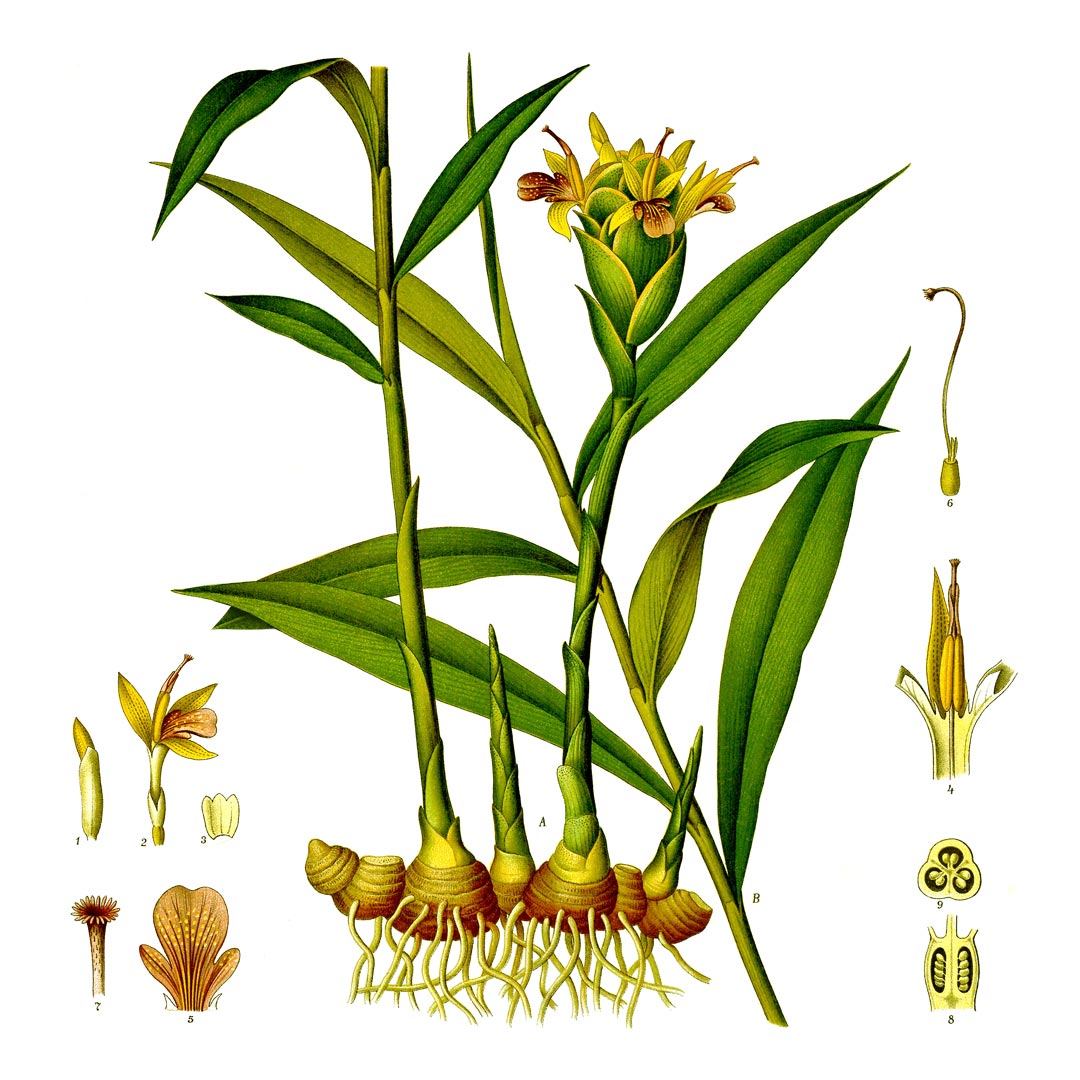
Ginger
Zingiber officinale
Common Name: Ginger
Arabic name: زنجبيل
TCM name: Sheng jiang
Ayurvedic name: Adrak
Family: Zingiberaceae
Parts Used: Rhizome
Actions: Antiviral, Anti-inflammatory, Carminative, Antispasmodic, Circulatory Stimulant, Radioprotective
Taste: Spicy
Energy: Warming
Native To: South Asia
Geographic Distribution: South Asia, East Africa, the Caribbean, India, Europe
Botanical Description: A reedy, leafy stemmed perennial that grows up to 2 feet, ginger shoots up a tall stem in the spring and has lanceolate leaves. The flower stalk grows from the root and at the tip, develops an oblong and scalloped spike from which white or yellow flowers blossom.
History and folklore: Medicinal uses are detailed extensively in early Traditional Chinese Medicine and Indian medical texts as well as ancient Roman, Greek, and Arabic traditions.
Uses: Ginger is a warming herb with a fiery nature. By stimulating circulation and energy, it enhances the "fire" in the body that supports digestion, heart health, immunity, and reproductive system vigor and balance. Its warming nature is especially good for cold, damp, and stagnant conditions.
A cup of ginger tea will warm a body chilled by weather or the flu, and its diaphoretic (sweat-inducing) ability can also cool an overheated or feverish body. By relaxing the muscles surrounding the arteries and then stimulating arterial circulation, ginger delivers warmth to the body’s extremities, either warming cold hands and feet or promoting sweating that helps cool the body. Combined with the antimicrobial properties and ability to thin mucous and support expectoration, this temperature modulation ability makes ginger an effective ally for supporting those with colds and flu. Ginger’s volatile oils stimulate the immune system to fight bacterial and viral infections. Ginger’s antiviral actions include stimulating macrophage activity, preventing viruses from attaching to cell walls, and acting as a virucide. Ginger is perhaps best known as an anti-spasmodic that alleviates nausea, motion sickness, and morning sickness. This effect is attributed to the relaxing nature of its aromatic oils. Ginger is also a carminative and digestive aid. By warming the stomach, it improves digestion, bile secretion, fat digestion, and movement of food through the digestive tract, reducing stagnation, irritation and gas. The warming, stimulating, and anti-spasmodic nature of ginger is also helpful for menstrual cramps and painful ovulation, promoting menstruation.
Safety: Ginger may interact with certain medications like Warfarin, and medications for diabetes and high blood pressure. Ginger may increase risk of bleeding. Traditional Chinese Medicine practitioners caution women who are pregnant not to use more than 2 grams of dried ginger a day.
Back to top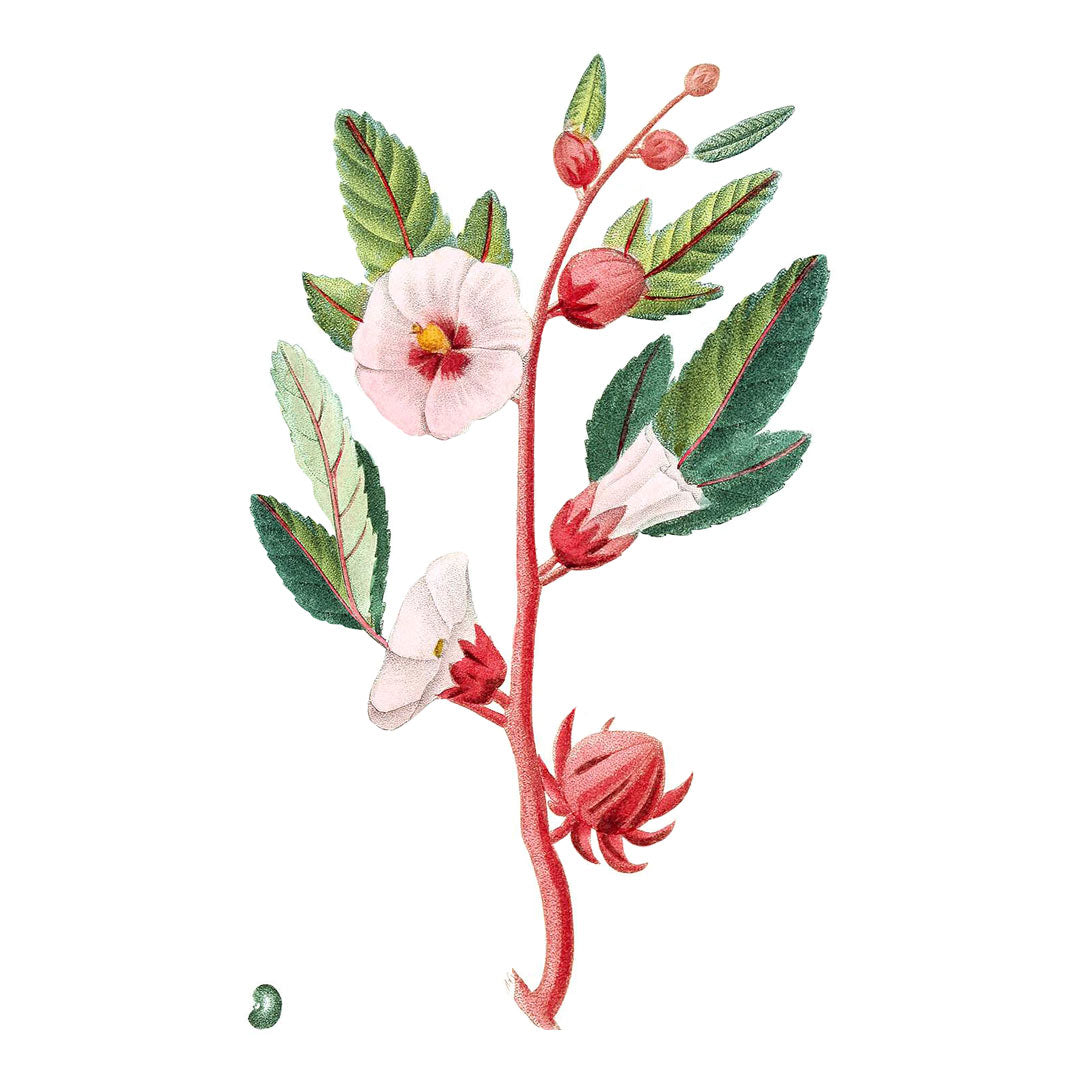
Hibiscus
Hibiscus sabdariffa
Common Name: Hibiscus, roselle, Sudanese tea, red tea, Jamaica sorrel
Arabic name: كركدية
Family: Malvaceae
Parts Used: Calyces
Actions: Astringent, Balances hormones, Antibacterial, Anti-catarrhal, Anti-inflammatory, Antimicrobial, Antioxidant, Diuretic, Cardiotonic, Hepatic, Hypocholesterolemic, Immune Stimulant, Reproductive tonic
Taste: Astringent, Sour
Energy: Cooling, Drying
Native To: North Africa, Southeast Asia
Geographic Distribution: Tropical and subtropical regions throughout world
Botanical Description: Hibiscus sabdariffa has large flowers that can be a variety of colors (typically ranging from yellow to white to pink) with a reddish-purple center. The flowers are up to 4 inches in diameter. The calyx, which is the outermost whorl of the flower, consists of dark red sepals that become fleshy and fruit-like after the flower is done blooming. The calyx protects a light green to brown ovoid fruit as it develops and matures. The erect shrub is up to 8 feet tall and has 3-7 lobed palmate leaves arranging alternately on the branching reddish stems. Hibiscus grows from a long taproot.
History and folklore: The luscious calyces are harvested and used fresh or dried to make tea, tincture, glycerite, syrup, infused honey, or jams. Hibiscus tea is a beloved drink in many cultures throughout the world, often prepared sweetened and with cinnamon, cloves, nutmeg, ginger, lemon juice, or mint. It is called Sorrel in the Carribbean, Agua de Jamaica in Latin America, Karkade in north Africa, Italy, and Russia, Arhul ka phool in India, and sour tea in Iran. Traditionally, hibiscus calyces have been used throughout the world as the aforementioned beverages as "refrigerants" to cool the body; in Egypt as a diuretic and for cardiac and nerve diseases; in North Africa for coughs and sore throats; in Europe for colds and upper respiratory tract congestion, sleeplessness and as a laxative and diuretic; and in Iran for hypertension.
Uses: Hibiscus is high in vitamin C. It contains plant acids (oxalic, malic, hibiscic, and citric) responsible for the tart flavor, anthocyanins, mucilaginous polysaccharides, anti-inflammatory polyphenols, flavonoids, and minerals such as iron, phosphorus, calcium, magnesium, aluminum, magnesium, sodium, and potassium. It is rich in antioxidants. The sour, astringent, cooling nature of hibiscus help to cool and regulate the body’s temperature as well as tone and cool irritated tissue and mucus membranes throughout the digestive tract and genitourinary system. This is particularly indicated in the case of overheated states and inflammation in the body, such as irritation in the liver, stomach, bladder, urinary tract, uterus, or colon. Hibiscus is also clearing, helping to move stuck mucus and energy throughout the digestive system, lungs, circulatory system, and reproductive system. Due to its high vitamin C and antioxidant content, hibiscus helps strengthen the immune system and acts as an immunostimulant to help fight off colds and infections. Its antioxidants keep our cells healthy, while its ability to help stuck mucus to flow helps alleviate congestion in the respiratory system. Hibiscus is purported to support cardiovascular health, reducing and maintaining healthy blood pressure and cholesterol levels. Hibiscus is an ally for the urinary system, as well. Hibiscus is a great plant for prevention of urinary tract infections (UTIs) due to its antibacterial activity and for treatment of bladder infections. Due to its diuretic action, hibiscus is helpful for prevention of uric acid buildup. Hibiscus is an ally for the reproductive system as well. It is balancing to hormones, its astringent nature is useful for regulating menstrual flow and checking excessive bleeding, and its antispasmodic action helps relieve menstrual cramps. On an energetic level, hibiscus is a very sensual, pleasureful plant, its diuretic properties encouraging movement and release in the sacral region while its pleasureful nature helps one open to intimate connection and receiving.
Safety: Hibiscus sabdariffa is considered safe. Extremely high doses of the extract could be toxic to the liver. Hibiscus should be avoided during pregnancy as there are some reports of it stimulating menstruation.
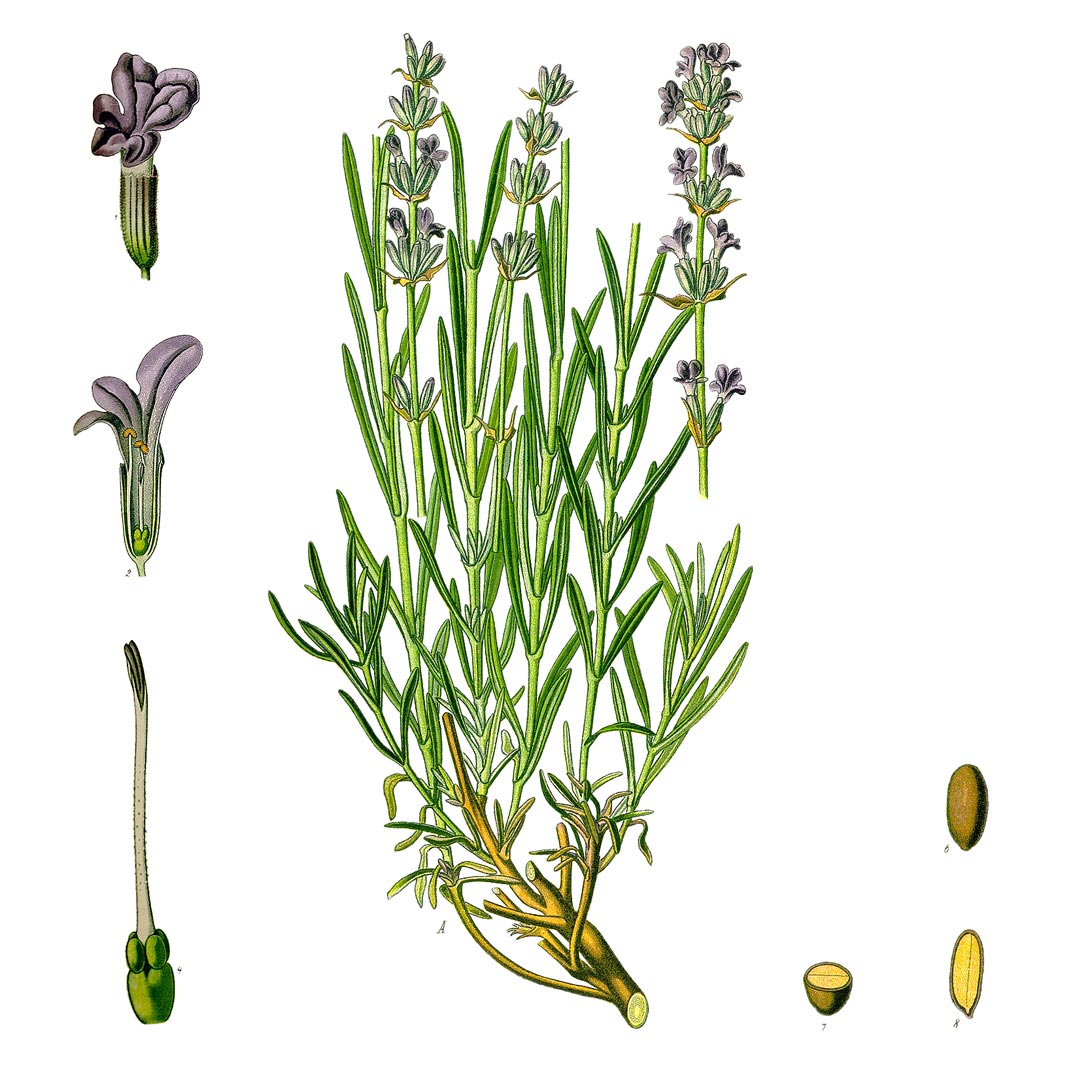
Lavender
Lavandula angustifolia
Common Name: Lavender
Arabic name: خزامى
TCM name: Xun Yi Cao
Family: Lamiaceae
Parts Used: Flowers
Actions: Nervine, Anxiolytic, Carminative, Antispasmodic, Circulatory Stimulant, Antibacterial, Antidepressant
Taste: Bitter (mild)
Energy: Drying, Cooling
Native To: Mediterranean region, southern Europe, and parts of northern Africa, northeast India, and southeast Asia
Geographic Distribution: Mediterranean, Europe, United States, Australia
Botanical Description: Perennial shrub with up to 3 feet tall spikes holding whorls of blue to violet small flowers. Leaves are small and diverse, ranging from simple to pinnate to pinnate-toothed, to multiple pinnate, and dissected. Leaves are typically covered in fine hairs.
History and folklore: The name lavender comes from the Latin word lavare, "to wash", originating from the Romans who used lavender to scent their baths. Lavender has long been used for cleansing purposes, and was strewn about households to ward off plague and tucked into cupboards and drawers to repel insects.
Uses: Lavender’s volatile oils are antibacterial and are effective against staph, enterococcus, streptococcus, and pneumonia. Lavender's strong scent is repellent to flies, mosquitos, and moths, and it effectively kills lice and parasites. Due to its antibacterial and antiseptic properties, lavender is useful for disinfecting cuts, wounds, and sores while it soothes pain and aids healing. It also soothes the itch and pain of insect bites. As a burn treatment, lavender essential oil reduces the severity and scarring of the burn and speeds healing. Lavender really shines as a nervine tonic for treatment of nervous system complaints such as anxiety, depression, insomnia, and headache. In an anxious or stressful situation, inhaling the scent of lavender or drinking its tea can calm and relax the anxious mind, bringing perspective and enabling the clearer thinking necessary to ease the situation. Several scientific studies suggest lavender alleviates anxiety and depression. By relaxing tension, lavender also may bring relief to headache sufferers. Rubbing lavender essential oil mixed with a carrier oil on the temples often brings quick relief.
Lavender is a gentle tonic for strengthening the nervous system in the case of nervous debility or exhaustion. The sweet spirit of lavender uplifts and balances emotions, eases mild depression and restores strength and vitality. It’s like a mother’s hand on your back, gentle and loving yet strong and supportive. As such, it can also be an ally during grieving. Lavender acts as a mild sedative to resolve insomnia.
Safety: Some sensitivity reactions and have occurred with the essential oil.
Back to top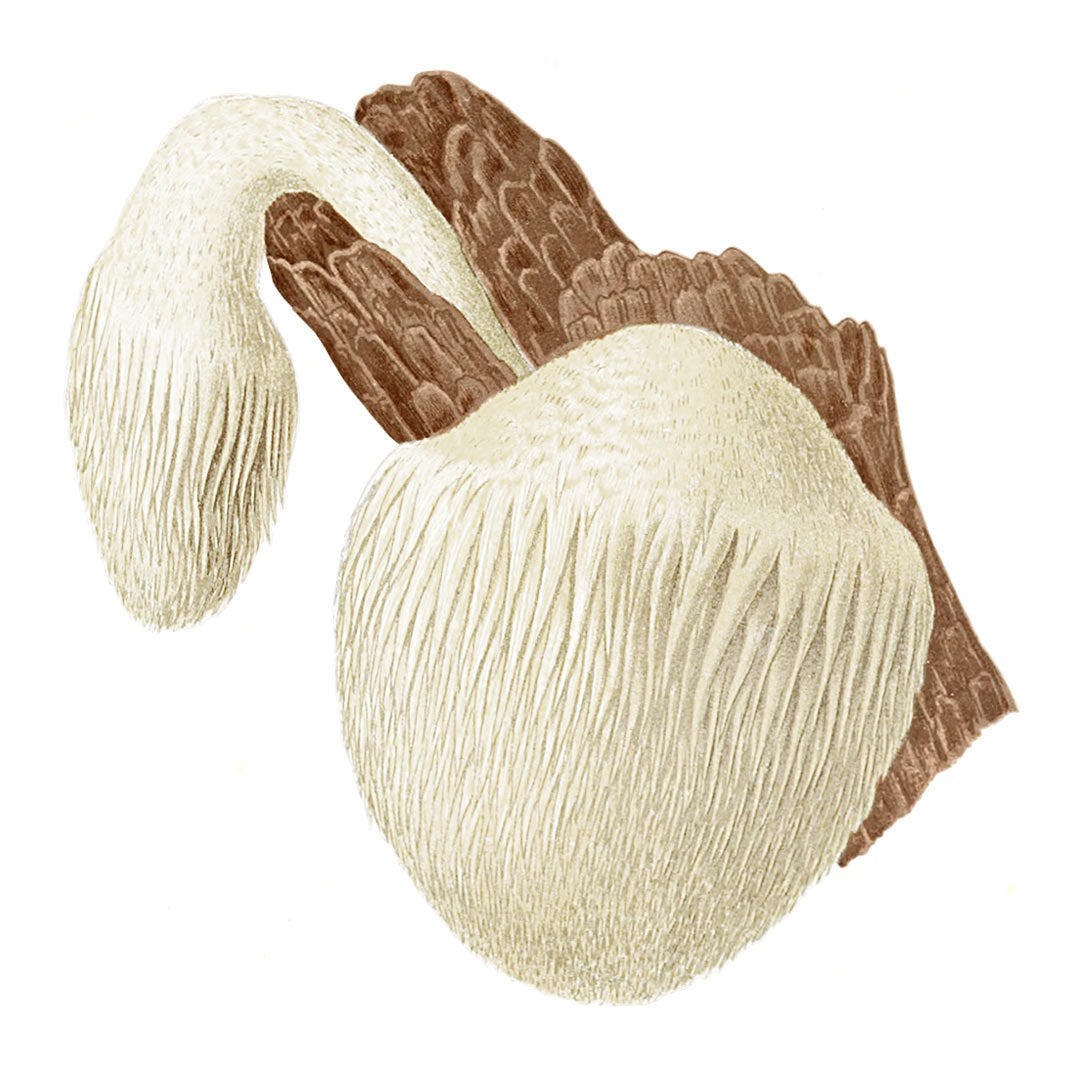
Lions mane
Hericium erinaceus
Common Name: Lion’s mane, Bear’s head, Monkey’s head, Comb tooth, Bearded tooth mushroom, Satyr's beard, Bearded hedgehog mushroom, Pom-pom mushroom, Bearded tooth fungus
TCM name: Hóu tóu gū
Family: Hericiaceae
Parts Used: Fruiting bodies, mycelium
Actions: Antibiotic, Anticarcinogenic, Antidepressant, Antifatigue, Antihypertensive, Anti-inflammatory, Antimicrobial, Antioxidative, Antisenescence, Anxiolytic, Cardioprotective, Cognitive support, Hepatoprotective, Immunomodulant, Neuroregenerative, Nephroprotective, Neuroprotective
Taste: Bland, slightly sweet, slightly savory
Energy: Sweet, neutral
Native To: North America, Europe, China, and Japan
Geographic Distribution: China, Japan, Europe, North America, Australia
Botanical Description: Hericium erinaceus is a pale white to light beige toothed fungi that naturally grows on dying wood in forests and tends to grow in a single clump of dangling spines that form round mushroom bodies. Lion's mane has no stipe, commonly called a stalk, and no distinct cap, and it always grows on wood. The spore print of Hericium erinaceus is white. The spines of lion’s mane hang evenly in a continuous clump rather than off of a branched structure. The globose clumps of spines will typically be between 3-12 inches broad and tall.
History and folklore: The Japanese name for Hericium erinaceus, yamabushitake, means "those who sleep in the mountains". The name relates to a garment which is both billowy and light in color which is worn by hermit monks of the Shugendo sect of ascetic Buddhism. In China, the name shishigashira means "lion’s head". The Traditional Chinese Medicine (TCM) name hóu tóu means "baby monkey", perhaps for its furry exterior and arboreal habitat. The French culinary name is ponpon du blanc, for the light color and shape, which resembles the decorative pom-pom.
Uses: In terms of the Traditional Chinese Medicine perspective and philosophy it is said that Hóu tóu gū strengthens the stomach, regulates Qi, tonifies the spleen, promotes digestion, calms the shen, and strengthens the brain.
The most fundamental traditional herbal use for lion’s mane is for gastrointestinal (GI) support. In Chinese medicine it is highly regarded as both a safe and nutritive food and is indicated for stomach ailments. Traditional use suggests that lion’s mane has the potential to repair and protect gastrointestinal tissue, particularly the stomach in the case of ulcers. In China the mycelium is used to make pills which are used for these purposes. Additionally, some Native American tribes have a history of using lion’s mane as a styptic to stop bleeding of minor cuts and wounds.
In traditional use, this mushroom has also been revered as a longevity tonic for the mind. Lion’s mane’s reputation has to do with preserving normal cognition and possibly promoting better mood in adults, particularly those who are middle-aged and older.
There has been additional research on the specific mechanisms by which lion’s mane may have unique activity on the nervous system. Lion’s mane extracts as well as the isolated constituents hericenones and erinacines are said to increase nerve growth factor (NGF), which is associated with nerve repair and growth in the brain.
Safety: No known safety issues.
Back to top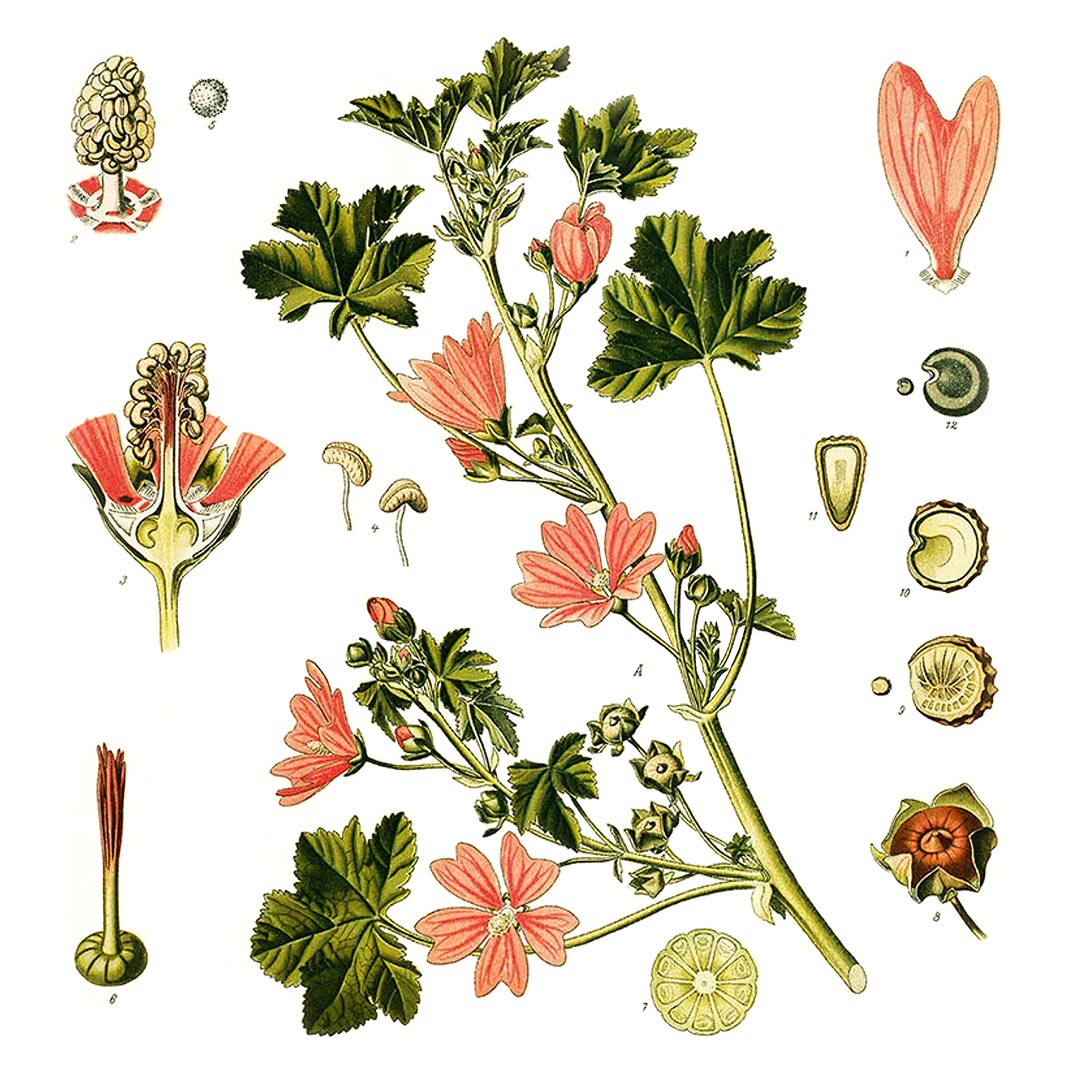
Malva
Malva sylvestris
Common Name: Mallow, high mallow, common mallow, Alcea rosea, hollyhock
Family: Malvaceae
Parts Used: Leaves, root, flowers
Actions: Antibacterial, mild astringent, anthelmintic, demulcent, diuretic, laxative, emollient, expectorant, inflammation modulating
Taste: Sweet, salty
Energy: Neutral to cooling depending on constitution
Native To: Macaronesia, Europe, Central Asia, West Himalaya
Geographic Distribution: present throughout the world
Botanical Description: The Common or Blue Mallow is a robust plant 3 or 4 feet high, growing freely in field, hedgerows and on waste ground. Its stem is round, thick and strong, the leaves stalked, roundish, five to seven lobed, downy, with stellate hairs and the veins prominent on the underside. The flowers are showy, bright mauve-purple, with dark veins. When they first expand in June, the plant is handsome, but as the summer advances, the leaves lose their deep green colour and the stems assume a ragged appearance.
History and folklore: Mallow has enjoyed a prominent role in many cultures throughout history, with the Chinese and the Romans being just two examples. The Chinese were making cups of reddish mallow tea as far back as 5000 years ago. Meanwhile, the Romans mixed mallow with oil, salt, honey and wine to make “omnimorbium”, an all-purpose remedy. Among the varieties of Mallow used in traditional medicine, the Sylvestris type emerges for its multiple benefits as archaeological studies in Syria have proven the consumption of this plant for medicinal purposes already 3000 years ago.
Uses: Mallow has been called the ‘softest’ plant because it has anti-inflammatory, slightly laxative and soothing properties. Mallows are mildly astringent, which means they help to tone the mucosal membranes and the skin. It also has a vulnerary action with an ability to staunch mild bleeding. Combined with its soothing, emollient and moisturizing properties, you can see why it is useful for people who have patterns of heat and inflammation in their digestive tract. This includes ulcers, gastritis, colitis, and enteritis, as well as Crohn's disease. It can also support people recover from leaky gut syndrome, commonly caused by prolonged use of non steroidal anti inflammatories such as aspirin.
Respiratory infections: The herb is a powerful demulcent for coughs, colds, sore throats, asthma and chest troubles.
Sore throats: Mallow can help soothe sore throats, especially those that are hot and dry and in need of moisture and cooling. The flowers are commonly made into a syrup for this purpose.
Immune system: Another less known affinity of mallow is its support for the immune system because of its actions on the mucous membranes.
Safety: In large doses, mallow can be laxative and purgative. While it can take a while to get to grips with the concepts of energetics, it is important to remember that mallow is not ideal to give to people with cold/wet/damp conditions.
Back to top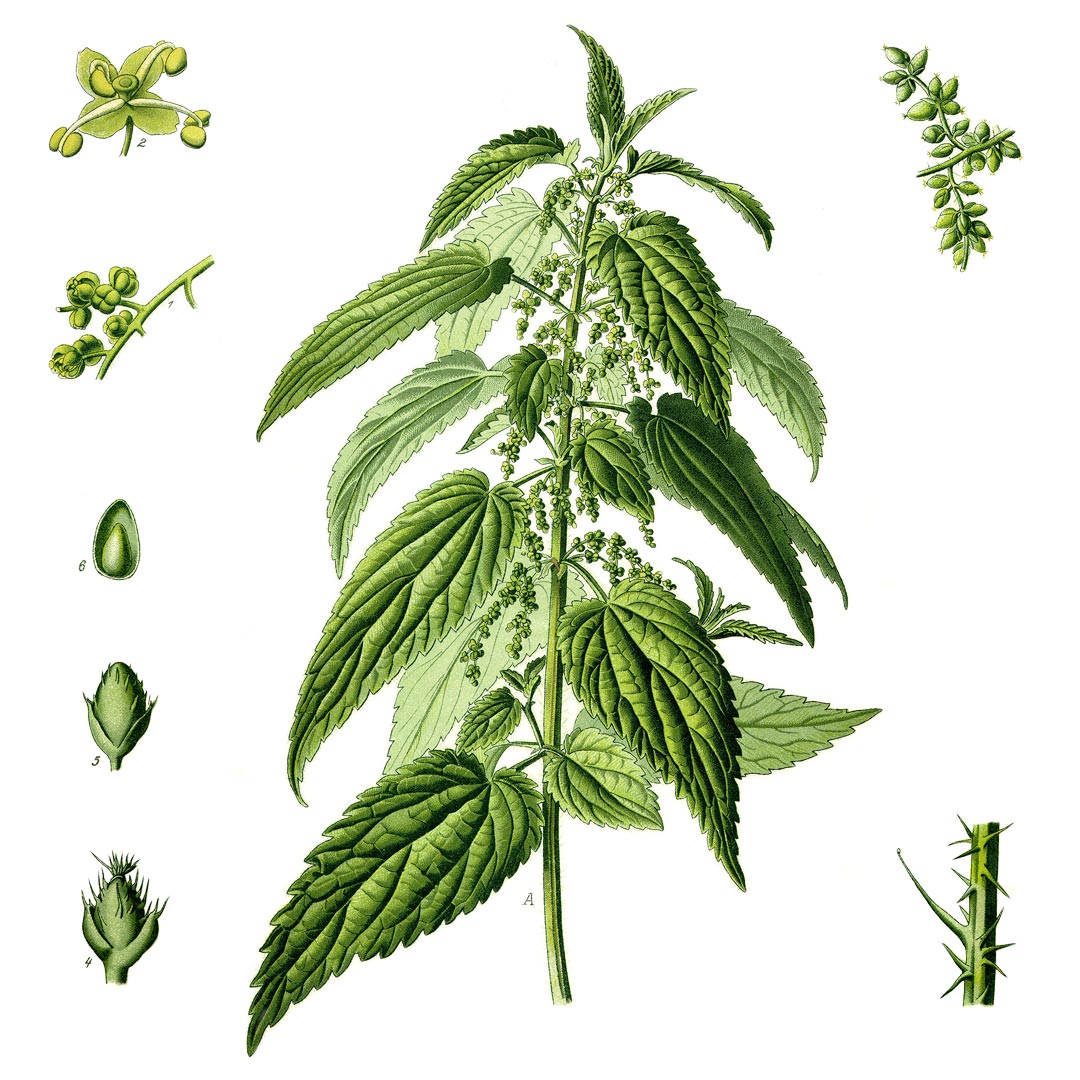
Nettle
Urtica dioica
Common Name: Nettle, common nettle, stinging nettle
Arabic name: قُرَّاص
Family: Urticaceae
Parts Used: Leaves, stalks, rhizomes, seeds
Actions: Alterative, Antihistamine, Anti-inflammatory, Astringent, Diuretic, Nutritive
Taste: Astringent, Salty
Energy: Cooling, Drying
Native To: Europe, Asia
Geographic Distribution: Temperate regions throughout world
Botanical Description: Nettle grows from 2-6 feet tall on a square, fibrous stem with deep grooves running along its length. The dark green leaves are ovate and sharply toothed with a heart-shaped base and a pointy tip. They are located in opposite pairs and become progressively smaller toward the top of the stem. The leaves and stems are covered with tiny, hollow hairs tipped with silica. Nettle spreads by rhizomes, so each plant can have multiple stems and thus nettle typically grows in dense colonies. The tiny, inconspicuous green flowers droop in bunches from the leaf axils (Foster, 1993; Thayer, 2006).
Uses: Nettle has been used as food, medicine, and fiber for thousands of years. The stalks and leaves, seeds, or rhizomes are (carefully) harvested and used to make tea, infusion and tincture. The spring-gathered stalks and leaves can be eaten as a cooked green like spinach or juiced, while the dried seeds can be eaten directly. Nettle’s nourishing and herbal action is attributed to its rich vitamin, mineral, amino acid, and chlorophyll content, as well as formic acid. It contains abundant calcium, magnesium, silica, iron and vitamins A, C, E, and K, as well as several other minerals. The high mineral and chlorophyll content gives the nettle a salty, swampy taste slightly reminiscent of seaweed. Energetically, nettle is cooling and drying and is astringent due to its tannin content.
It is a quintessential nourishing herbal tonic, and can be drunk or eaten daily. Nettle nourishes, supports, and energizes the whole body, and is richly nourishing to the blood. Nettle is a deeply nourishing tonic for the adrenals and kidneys. In addition to nourishment, nettle is also an alterative, meaning it purifies the blood and assists the body in nutrient and protein assimilation, neutralization of acid, and elimination of waste. Nettle helps to detoxify the body and is used as a spring tonic after a long winter of eating root vegetables, cooked grains, and/or heavy meats. For these purposes, either drink nettle as a nourishing infusion, steam or sauté the tops of spring nettles and use them as you would any green leafy vegetables, or juice the leaves and stalks to make a green juice.
Nettle has the added benefit of helping to maintain even blood sugar levels; research indicates that nettle contains both hypoglycemic and hyperglycemic constituents.
Nettle is suggested for use during pregnancy and the post-partum period including lactation, and not just for its nutritive qualities. As a galactagogue, nettle increases the quality and quantity of breast milk. As a hemostatic (due to its high level of vitamin K) and an astringent, nettle can help ease uterine bleeding and hemorrhage after childbirth. It is also used to reduce excessive menstrual bleeding or excessive bleeding anywhere in the body.
Safety: Nettle is considered nutritive and safe, although some allergic reactions have been reported. Nettle stings may cause discomfort, of course. Internal use may decrease the efficacy of anticoagulant drugs. Nettle leaf may modify glucose regulation and should only be taken by diabetics under the guidance of a qualified healthcare professional.
Back to top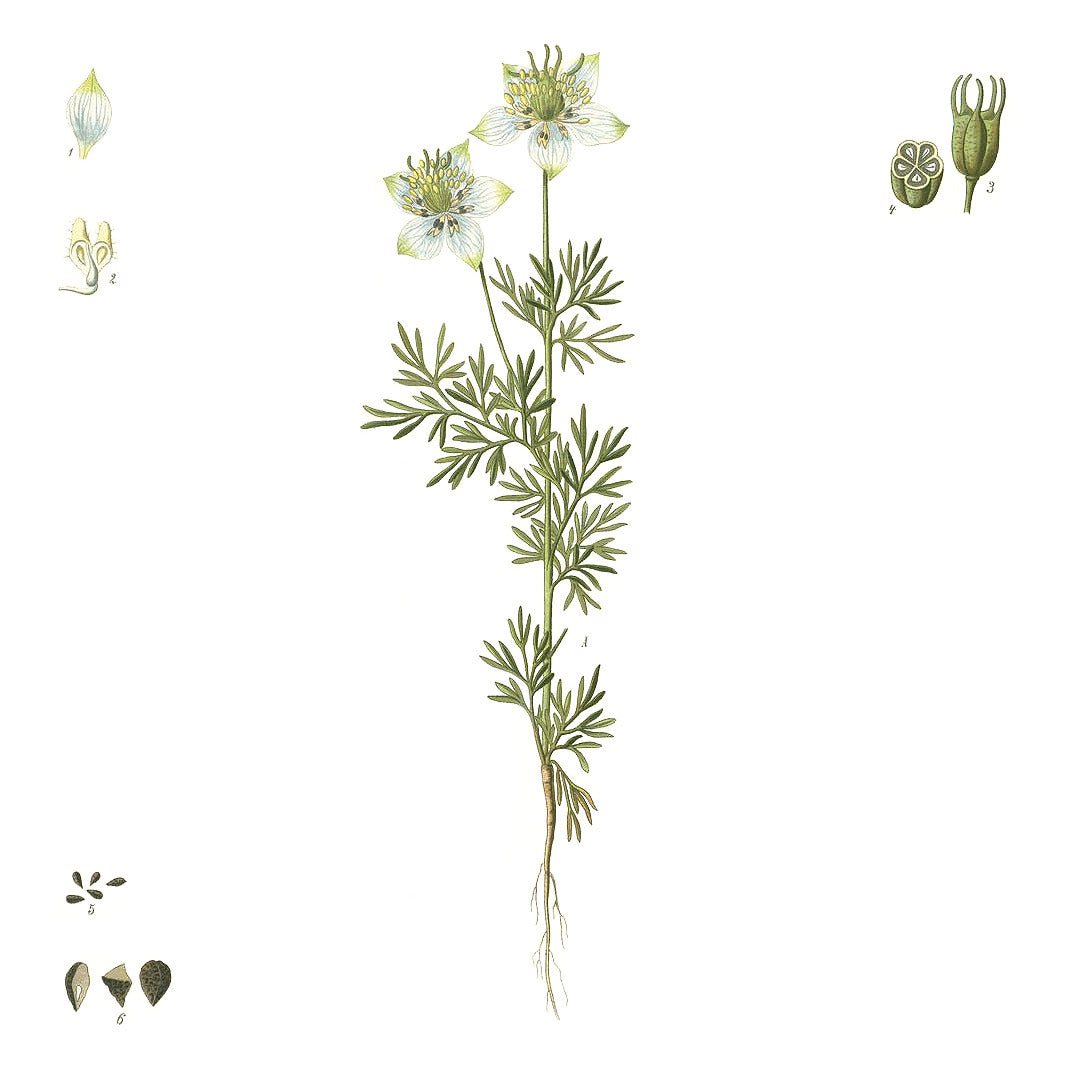
Nigella
Nigella sativa
Common Name: Black cumin, Fennel Flower, Nutmeg Flower, Black seed, Black Caraway, Roman Coriander, Damascena, Devil in-the-bush, Wild Onion Seed
Arabic name: حبة البركة
Family: Ranunculaceae
Parts Used: Flowers, seeds
Actions: Antibacterial, antifungal, antihistaminic, antihypertensive, anti-inflammatory, antinociceptive, antioxytocic, antiparasitic, antiviral, diuretic, hematological, hepatoprotective, hypoglycemic, immunopotentiating
Taste: Spicy
Energy: Warming
Native To: Southern Europe, North Africa and Southwest Asia, cultivated in many countries in the world like Middle Eastern Mediterranean region, South Europe, India, Pakistan, Syria, Turkey, Saudi Arabia
Geographic Distribution: The genus likely originated in parts of the eastern Mediterranean, northeastern Africa, and southwestern Asian regions. Nigella sativa is found growing wild in regions of northern Africa, Turkey, Syria, Iraq, and Iran. The species is also cultivated on a commercial scale in northern Africa (Egypt, Tunisia, Sudan), eastern Africa (Ethiopia), western Asia (Iraq, Palestine, Jordan, Lebanon, Syria, Turkey, Yemen), and southern Asia (India, Iran, Pakistan).
Botanical Description: Nigella sativa is an annual flowering plant that grows at 20-90 cm tall, with finely divided leaves; the flowers are white, yellow, pink, pale blue or pale purple color, with 5-10 petals. The fruit is a large and inflated capsule consists of 3-7 united follicles, each containing several seeds. Seeds are small dicotyledonous, trigonus, angular, tubercular, black externally and white inside, odor slightly aromatic and taste bitter.
History and folklore: Nigella sativa has been widely used as a spice and flavoring agent in variety of food preparations such as in bread, yogurt, pickles, sauces, and salads. Black seed or black cumin (English), Habbatul Barakah (Arabic), Tikur azmud (Amharic), has long been used in traditional remedy in the Arabian countries, Far East Asia, Europe, and Africa. Nigella sativa has also been described as the miraculous plant and considered by earliest herbal specialists as "The herb from heaven". The Prophet Mohammed (PBUH) had described the curative powers of the black seed as "Hold on to use this black seed, as it has a remedy for every illness except death". Avicenna, a well-known physician of the 10th century famous for his book "The Canon of Medicine", has recommended use of Nigella seeds for enhancement of body’s energy and also support during recovery from fatigue and dispiritedness. Nigella sativa is also mentioned for its curative property in the Holy Bible and is also labeled as Melanthion by Hippocrates and Dioscorides.
Nigella sativa is still widely used in Asian and Arabic systems of medicine. As such, quality standards monographs providing specifications and test methods for Nigella sativa seed have been published in the Ayurvedic Pharmacopoeia of India, Siddha Pharmacopoeia of India, and in the Unani Pharmacopoeia of India.
Uses: The medicinal use of black cumin seeds in various traditional herbal systems is known for a wide range of ailments which include different airway disorders, for pain such as chronic headache and back pain, diabetes, paralysis, infection, inflammation, hypertension, and digestive tract related problems administered in different kind of preparations. It has also been used topically where it is applied directly to the blisters, nasal abscesses, orchitis, eczema, and swollen joints.
In vivo and in vitro studies have shown nigella seed powder and oil to have antibacterial, antifungal, antihistaminic, antihypertensive, anti-inflammatory, antinociceptive, antioxytocic, antiparasitic, antiviral, diuretic, hematological, hepatoprotective, hypoglycemic, immunopotentiating, wound-healing, and respiratory-stimulant properties.
Safety: The minor and/or negligible toxicological effects and wider therapeutic margin of Nigella sativa and its active constituents, thymoquinone, as evidenced by various scientific studies, support its safe use for the long-term traditional food and medicinal purposes.
Avoid during pregnancy.
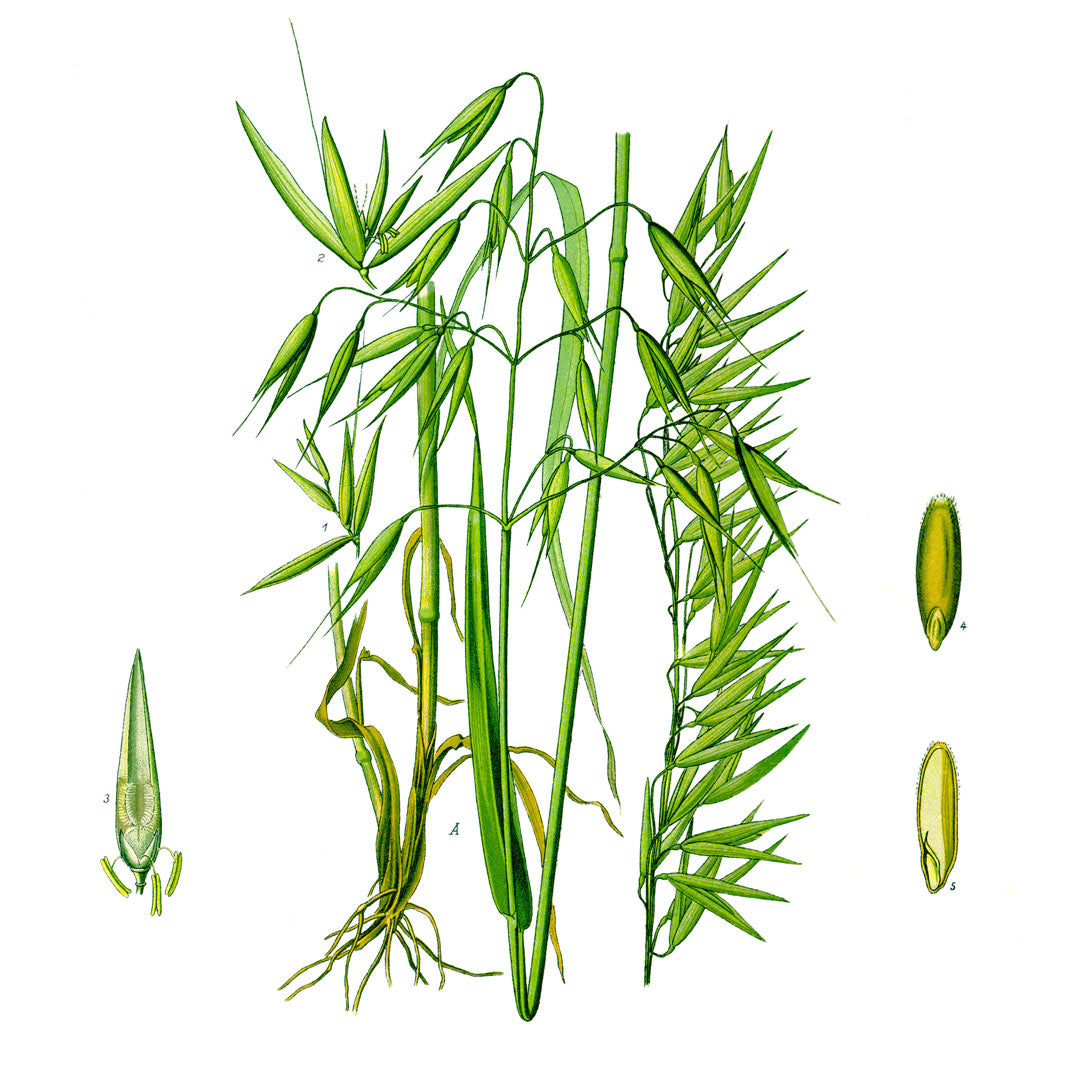
Oat
Avena sativa
Common Name: Oat, oatstraw, milky oat, wild oats, oatgrass, catgrass
Family: Poaceae
Parts Used: Milky oat tops; oat stem, oat straw
Actions: Antidepressant, Anxiolytic, Aphrodisiac, Cardiotonic, Demulcent, Emollient, Hypocholesterolemic, Immunomodulant, Nervine, Reproductive tonic, Trophorestorative, Nutritive
Taste: Slightly sweet, Refreshing
Energy: Cooling, Moistening, Sweet, Warming
Native To: Mediterranean region
Geographic Distribution: Cultivated and wild in temperate regions throughout the world.
Botanical Description: Oat grows to four feet tall with narrow, lance-shaped, flat, rough green leaves on a smooth stem. The flower consists of two-flowered spikelets that hang downward and develop into two husk-wrapped grains.
History and folklore: Avena sativa, a member of the grass family (Poaceae), is an annual plant native to the Mediterranean.
Uses: Oatstraw is considered a nourishing herb due to its rich nutritive profile of protein, carbohydrate, vitamins, and minerals. Oatstraw and the oat grain nourish, strengthen, and repair tissues and muscles throughout the body. It is easy to digest, and has a soothing effect on the intestinal tract due to the milky, lubricating substance released in particular from the oat grain.
The rich nourishment in oats helps build deep immunity. The rich vitamin B, calcium, and magnesium content in oats helps soothe and strengthen nerves. Oatstraw and milky oats are considered one of the best remedies for “feeding” and restoring the nervous system, particularly in times of stress and in the case of nervous system weakness or exhaustion associated with depression, overwork, or emotional trauma. Symptoms may include irritability, chronic fatigue, inability to focus, loss of libido, and heart palpitations. Oatstraw infusion helps mellow the mood, ease anxiety, combat the effects of daily stress, and resolve sleeplessness. As a tincture, milky oats are indicated for the same nervous system conditions as oatstraw.
Through its effects on the nervous, endocrine, cardiovascular, and immune system, oat straw supports physical, mental, and emotional strength and resilience. As the tall oat plant which sways gracefully with the changing winds yet remains firmly rooted and grounded in the Earth, so too will those who take oat’s medicine.
Safety: Of concern to individuals with celiac disease is the fact that oats are often processed in facilities that also process wheat and other gluten-containing ingredients and may become contaminated with gluten.
Back to top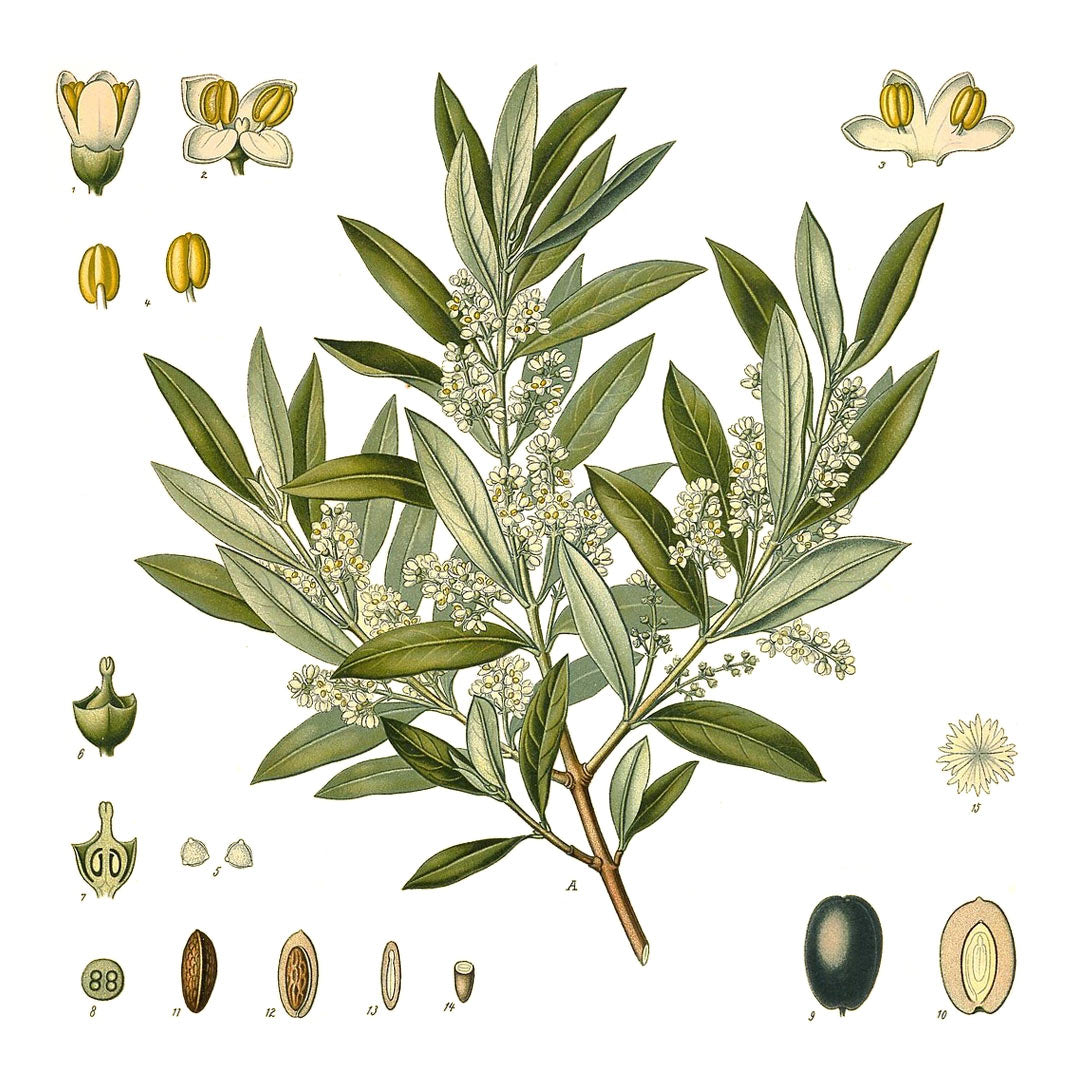
Olive leaf
Olea europaea
Common Name: Olive leaf, African olive, black olive, European olive, feral olive, olive, wild olive
Family: Oleaceae
Parts Used: Leaf
Actions: Antibacterial, Anticancer, Antifungal, Anti-inflammatory, Antimicrobial, Antioxidant, Antiseptic, Antiviral, Astringent, Neuroprotective
Taste: Astringent, Bitter
Energy: Cooling, Drying
Native To: The cultivated European olive (Olea europaea subs. europaea) originated in the eastern areas of the Mediterranean basin in Asia Minor and is now considered native to southern Europe, temperate Asia, and Africa. It is often conflated with the African subspecies (Olea europaea subsp. cuspidata), which originated in Africa.
Geographic Distribution: Cultivated and wild in temperate regions throughout the world.
Botanical Description: Olive trees are evergreen and may live for more than 1,000 years. The leaves have very short stalks, are arranged oppositely, and are lanceolate, ovate, and narrow in shape. The mature leaves are leathery and waxy in texture, green on the upper side, and silvery-whitish below.
History and folklore: The venerable olive tree has been known and used by human beings even before the development of literature. While its leafy boughs were employed in many ancient cultural contexts—the echoes of which survive today—very early herbal indications for the leaf along with their historical lineage have not yet been fully surveyed.
While the geographical origination and development of cultivated olives is a complex subject, the olive tree is known to have been cultivated in ancient Egypt: its boughs appear in temple art and funerary archaeology. Olive also appears in the Quran and is a symbol of peace in the Arab world. In Africa, olive leaf decoctions have traditionally been used in other types of infections, specifically for sore throats, colds, and diphtheria. In Tunisian folk herbalism, olive leaves are used for several types of inflammatory conditions and bacterial infections as well as cough, gingivitis, otitis, and jaundice. The leaf has been used in folk medicine contexts for diabetes as well. In the Beni Mellal region of Morocco, a recent ethnobotanical survey of herbalists, folk practitioners, and traditional healers demonstrated that olive leaf is in fact the most commonly employed botanical for this purpose; the same is true in the Souk Ahras province of Algeria, and it is also frequently used in Palestine. Water decoctions have apparently been used in Greek folk methods for high blood pressure for some time and it is traditionally used in Algeria for hypertension in decoction or infusion form, sometimes in oil maceration as well as in Morocco.
Uses: Olive leaf constituents have been tested against several Gram positive and Gram negative bacteria as well as fungi, and extracts have demonstrated a marked combined antifungal and antibacterial activity even at low concentrations. Another major area of olive leaf’s influence is cardiovascular wellbeing. Olive leaf also exerts an antitumor effect on many different types of cancer lines and is subsequently receiving much scientific attention in the cancer field.
Safety: There appear to be no known toxicities in either long or short-term usage of the leaf. Taking olive leaf with meals, however, may avoid gastrointestinal discomfort. Due to the fact that olive leaf lowers blood sugar levels, it may be considered contraindicated for individuals with hypoglycemia.
Back to top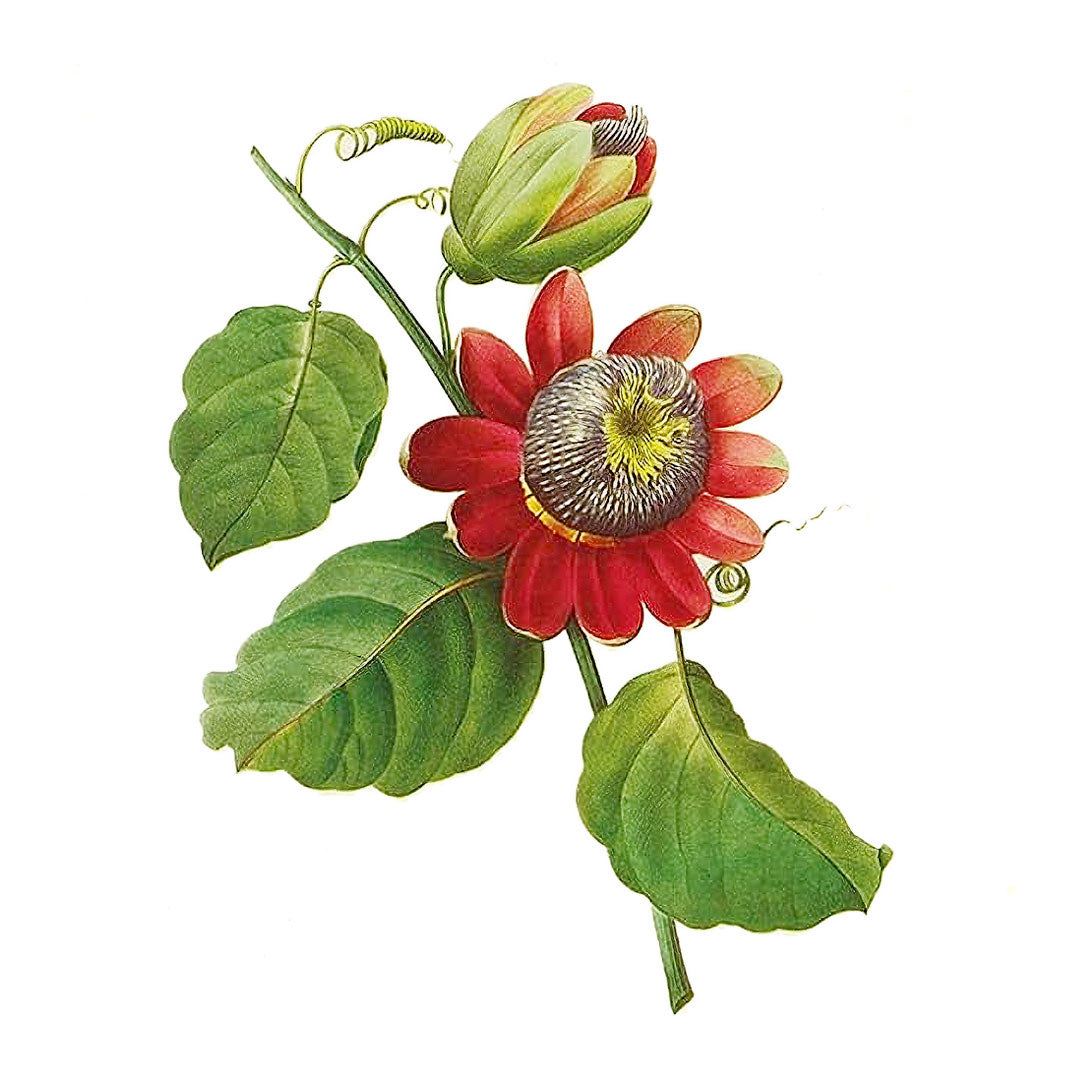
Passionflower
Passiflora incarnata L.
Common Name: Passionflower, purple passionflower, maypop, wild apricot, wild passion vine, passionflower, apricot vine
Family: Passifloraceae
Parts Used: Root and stem base, leaves and whole flowering tops, whole flowering plant, fruit
Actions: Nervine, Antispasmodic, Hypnotic, Anodyne, Anxiolytic, Sedative
Taste: Bitter, Sweet, Sour
Energy: Cooling, Calming
Native To: This particular species of passionflower is native to roadsides, prairies, plains, meadows, pastures, savannahs, stream and riverbanks, and woodland edges and openings of the eastern United States.
Geographic Distribution: West from Pennsylvania to Missouri, south to east from Texas to Florida. Now grown commercially worldwide.
Botanical Description: Passionflower is a perennial climbing vine that can reach up to 30 feet in height, using coiling, spring-like tendrils from the axils of leaves to "grab-onto" nearby structures. It can also sprawl along the ground forming thick patches. The deciduous leaves are trilobed, light to dark green. These unique and complex flowers have white to light purple petals and sepals which subtend the corona, a third whorl of fringey, crimped or wavy hair-like segments. Passionflower fruits are egg-shaped and fleshy, green when unripe and turning yellowish as they ripen.
History and folklore: From healing traditions originating in Brazil, Iran, Turkey, and India, there is widespread appreciation for the many ethnobotanical features of a variety of Passiflora species. Most of these features surround anxiolytic, anodyne and sedative properties with specific influence over the nervous system and the many symptomatic or pathological manifestations of neurological disease and mental illness. Specifically, Passiflora incarnata L. holds a similar prominent place in both traditional and modern herbalism within its North American native range. The Cherokee used the roots as a poultice to draw out inflammation in thorn wounds; tea of the root in the ear for earache; and tea of the root to wean infants. [iv] The Houma people infused the roots as a blood tonic. Passiflora incarnata L. is now cultivated and utilized world-wide as an iconic nervine, sedative, and antispasmodic, that offers specific and profound influence over the nervous system and its many functions.
Uses: Nervous system/antispasmodic: Passionflower is a nervine tonic which helps with insomnia, anxiety, depression, hypersensitivity to pain, headaches, agitation, transitioning from addictions. Passionflower has a specific action upon the medulla oblongata, a portion of the brainstem that oversees sleep, temporary fluctuations in blood pressure due to stress, and actions of the vagus nerve (specifically digestive and respiratory). Passionflower is best indicated for individuals who are weak, fragile, and/or exhausted.
Children: insomnia; trouble sleeping through the night; teething; colic; adjunct treatment in asthma; especially with panic around asthma attacks; whooping cough.
Safety: Passionflower extract is classified as generally regarded as safe.
Back to top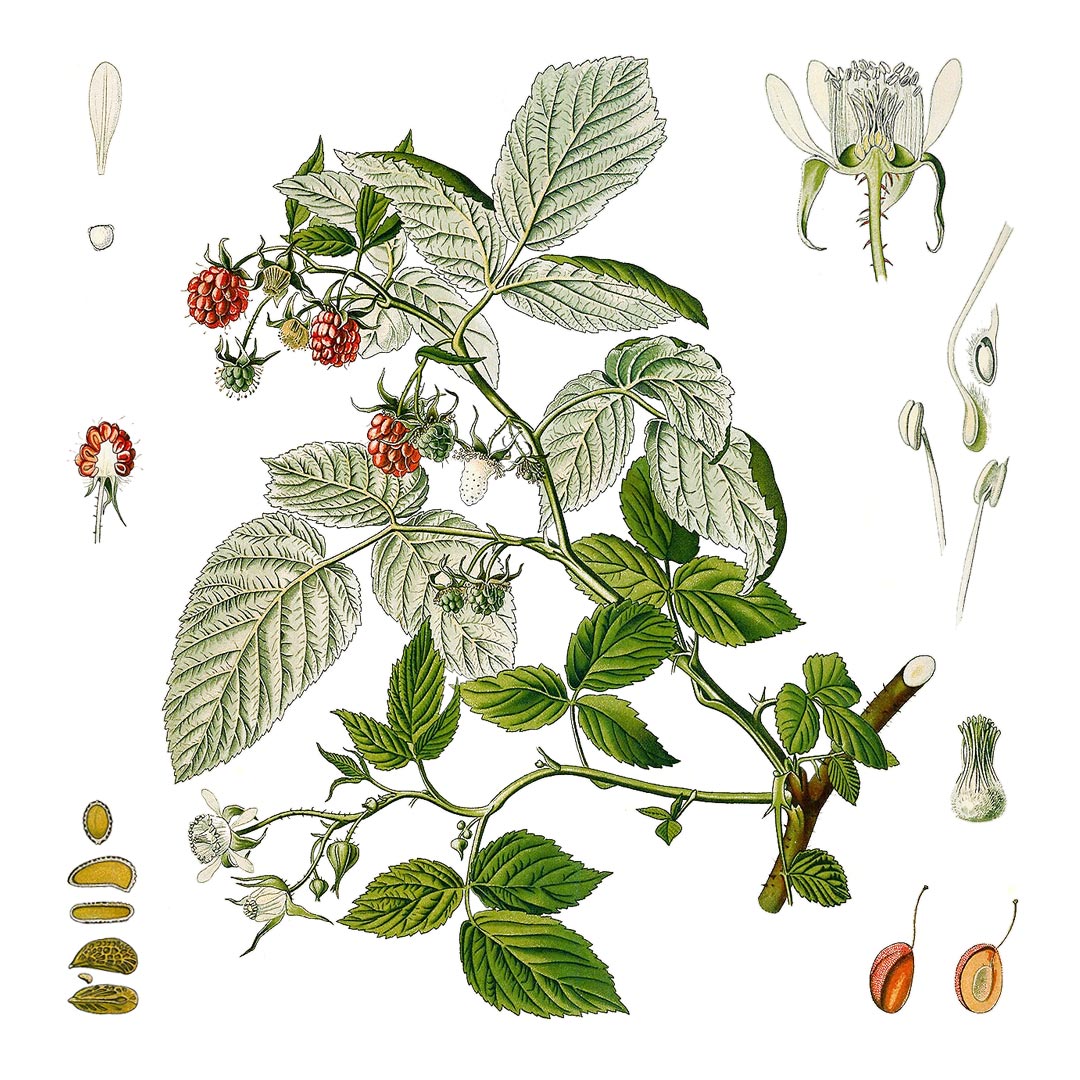
Raspberry leaf
Rubus idaeus, Rubus spp.
Common Name: Raspberry leaf, red raspberry
Arabic name: ورق التوت الأحمر
Family: Rosaceae
Parts Used: Leaves
Actions: Anti-inflammatory, Antioxidant, Antispasmodic, Astringent, Nutritive, Uterine tonic
Taste: Bitter (mild), Astringent, Sweet
Energy: Cooling, Drying
Native To: Rubus idaeus is native to temperate regions of Europe and Asia. Black raspberry is native to the eastern and central United States and Canada. Another species of black raspberry, sometimes called blackcap raspberry, is native to western North America, ranging from Alaska to Mexico.
Geographic Distribution: In addition to its native range throughout temperate Eurasia, Rubus idaeus can be found in parts of the United States, Canada, Australia, New Zealand, and Iceland (RBGK, n.d.a). The North American native Rubus occidentalis has been reported in western Russia and Czechoslovakia (RBGK, n.d.c).
Botanical Description: A deciduous perennial shrub with biennial canes, Rubus idaeus grows to about 0.5-3 m in height and tends to form thickets. In wild plants, first-year canes often produce only leaves; in the second year they produce lateral branches (floricanes) from which grow leaves and flowers. The smooth, round stems are woody with bristles and/or curved prickles. The leaves are green on top and silvery grey/white beneath.
History and folklore: The Cherokee have traditionally used the leaf as an antispasmodic for menstrual cramps and the root to address menstrual irregularities (Garrett, 2003). The Cherokee have traditionally used raspberry root as a uterine tonic to reduce the likelihood of miscarriage and ease labor pains (Garrett, 2003), and the Cree have used decoctions of the leaf and root for various issues related to childbirth (Young et al., 2015).
Uses: Raspberry has a long history of use for balancing menstruation. Raspberry leaf contains an alkaloid called fragarine, which in combination with the herb’s other beneficial constituents, gives tone to the uterus and other muscles of the pelvic region.
While raspberry leaf receives the most attention for its tonic effect on the womb, it is considered a general reproductive, genitourinary, and endocrine tonic for people of all genders. The herb is thought to strengthen the endocrine system and balance hormones; it is used to establish rhythm and regulate menstrual cycles in young people as well as restore irregular menstrual cycles.
Raspberry leaf is also widely used during pregnancy to strengthen the uterus and prepare the body for labor, a use which was originally introduced by Indigenous peoples of North America.
Today, it is one of the most commonly used herbs during pregnancy. It is considered an excellent tonic during pregnancy on two counts: its high vitamin and mineral content is richly nutritive for both parent and child, and its tonic properties help to strengthen the uterus in preparation for childbirth.
Raspberry leaf is a rich source of vitamins A, B, C, and E and minerals such as calcium, iron, phosphorus, potassium, magnesium, selenium, and manganese. It can be used as a nutritive tonic for low energy levels and during recovery from illness. When used as a nutritive tonic, raspberry leaf is often prepared as an infusion.
The leaf is particularly high in manganese, containing twice the amount of most herbs; manganese contributes to antioxidant actions in the body and supports bone health, wound healing, blood sugar regulation, and metabolism of nutrients. The herb is also a rich source of iron and is sometimes used to replenish iron-poor blood; it is often combined with nettle (Urtica dioica) leaf for this purpose.
Raspberry leaf also has antioxidant properties, which are attributed to the herb’s phenolic content. Researchers suggest that raspberry leaf’s high antioxidant activity, combined with its rich nutrient content, has the potential to guard against a variety of degenerative diseases such as diabetes, cancer, and atherosclerosis.
Safety: Raspberry leaf is contraindicated in anemia as it may interfere with the absorption of iron due to its high tannin content. Take raspberry leaf separately from metal ion supplements, thiamine medications, or alkaloid-containing medications or herbs. High doses of tannins may cause gastrointestinal irritation; use caution in inflamed or ulcerated conditions.
There is some difference of opinion about raspberry leaf’s safety during the first trimester. Some herbalists maintain that it can be safely used throughout the entire 9 months of pregnancy, while others suggest its use primarily during the second and third trimesters, and still others caution against its use during the first trimester due to its uterine-stimulant properties. Please consult a midwife, doctor, or an experienced herbalist if you have questions about using raspberry leaf during pregnancy.
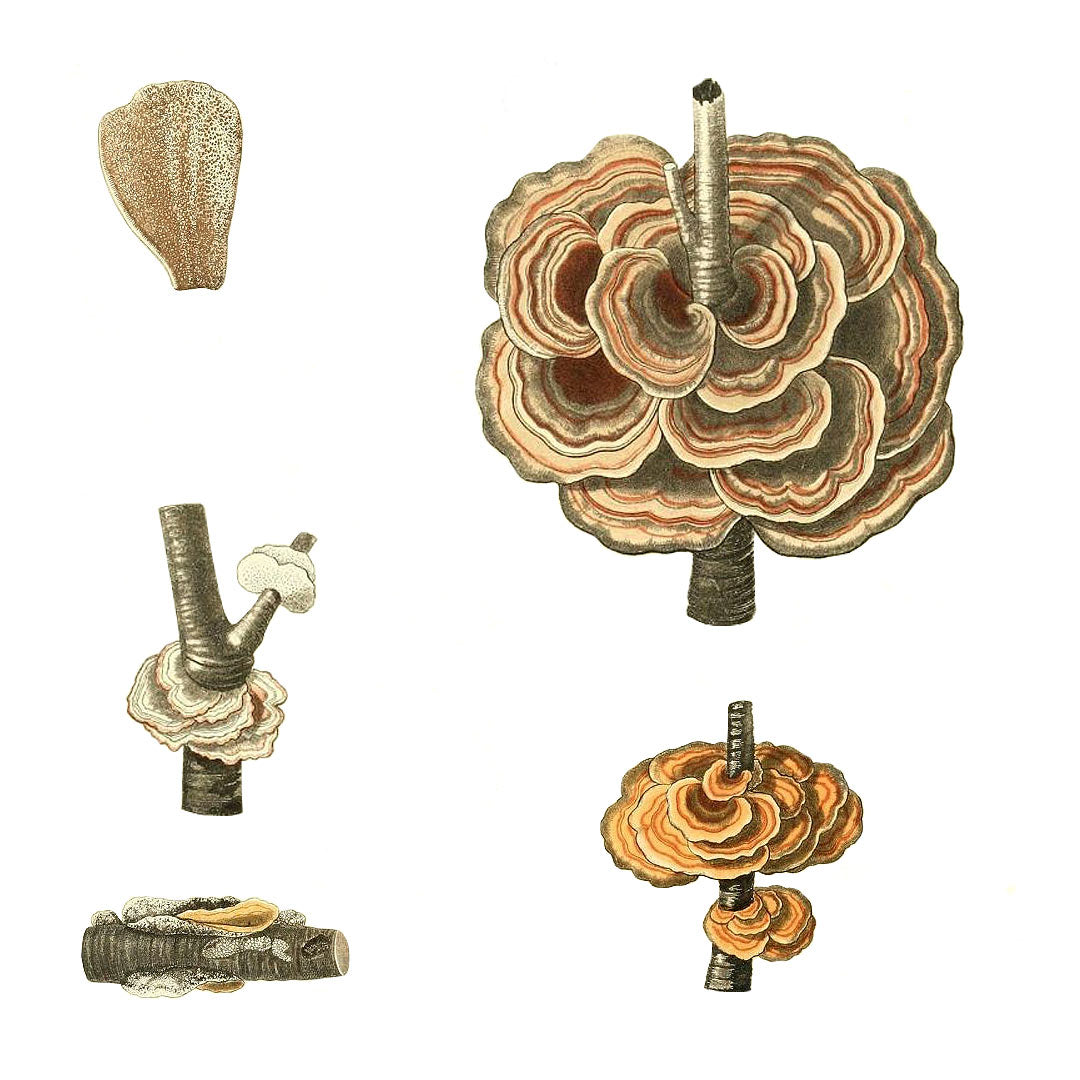
Reishi
Ganoderma lucidum
Common Name: Reishi
TCM name: Ling zhi, ling chi
Family: Ganodermataceae
Parts Used: Fruiting body
Actions: Antioxidant, Adaptogen, Antiviral, Anti-inflammatory, Hypocholesterolemic, Nervine, Hepatic, Immunomodulant
Taste: Bitter
Energy: Drying, Warming
Native To: Asia, particularly in countries like China, Japan, and Korea.
Geographic Distribution: Worldwide in both tropical and temperate climates.
Botanical Description: Reishi is a woody, dark mushroom of the species Ganoderma lucidum, characterized by a glossy, reddish-brown, kidney-shaped cap with a varnished appearance and a tough, woody texture. It is a polypore fungus, or bracket fungus, that grows on dead or dying hardwood trees, such as oak and maple, primarily in temperate and subtropical regions. The fruiting body can take on different shapes depending on the oxygen levels, appearing as either a shelf-like bracket or a "finger-like antler" structure.
History and folklore: Reishi is a beautiful polypore fungus with a long and venerable history of use in Traditional Chinese Medicine (TCM) and other Asian medicine traditions. Regional names for reishi provide a hint to its universal use as a life extending herb: Reishi means “divine” in the language of Japan, where it is also called mannentake or “10,000-year mushroom;” the Chinese call it ling zhi or “tree of life mushroom;” and in Vietnam, it is called linh chi, “supernatural mushroom.” At one time, reishi was used exclusively by royalty as a “superior herb” in ancient China, and today is used as a immunomodulant, adaptogen, anti-tumor, anti-inflammatory, hypocholesterolemic, liver protective, nervine and antiviral (Winston and Maimes, 2007). With its wide range of benefits, no wonder it was considered life extending!
Uses: Reishi is particularly useful for people with hypersensitivity, especially in the lungs in those with allergies or asthma, and reduces inflammation and increases the activity of helper T-cells in the immune airways. A few preliminary studies have also shown reishi to benefit the airways, although clinical trials are needed to study this effect more in humans.
An adaptogen that helps the body adapt to stress, reishi boosts general immune system strength through its action as an immunomodulator and immunostimulant. It is specifically indicated in “chronic stress with weakened conditions”—like recurrent infections. As an immune system modulator, it can both strengthen the body’s natural defenses or “down-regulate” overactive response in people with autoimmune disorders (Winston and Maimes, 2007). Reishi may also have anti-viral effects, and as part of a mixture of other herbs, has been shown to shorten the duration patients with the herpes simplex virus (Hijikata et al., 2007).
Safety: A few human cases of liver toxicity after ingestion of powdered reishi have been reported. These patients had taken traditionally prepared reishi for some time without incident before switching to powder, which may have been contaminated with adulterants or not prepared properly. It is therefore crucial to source quality reishi.
Back to top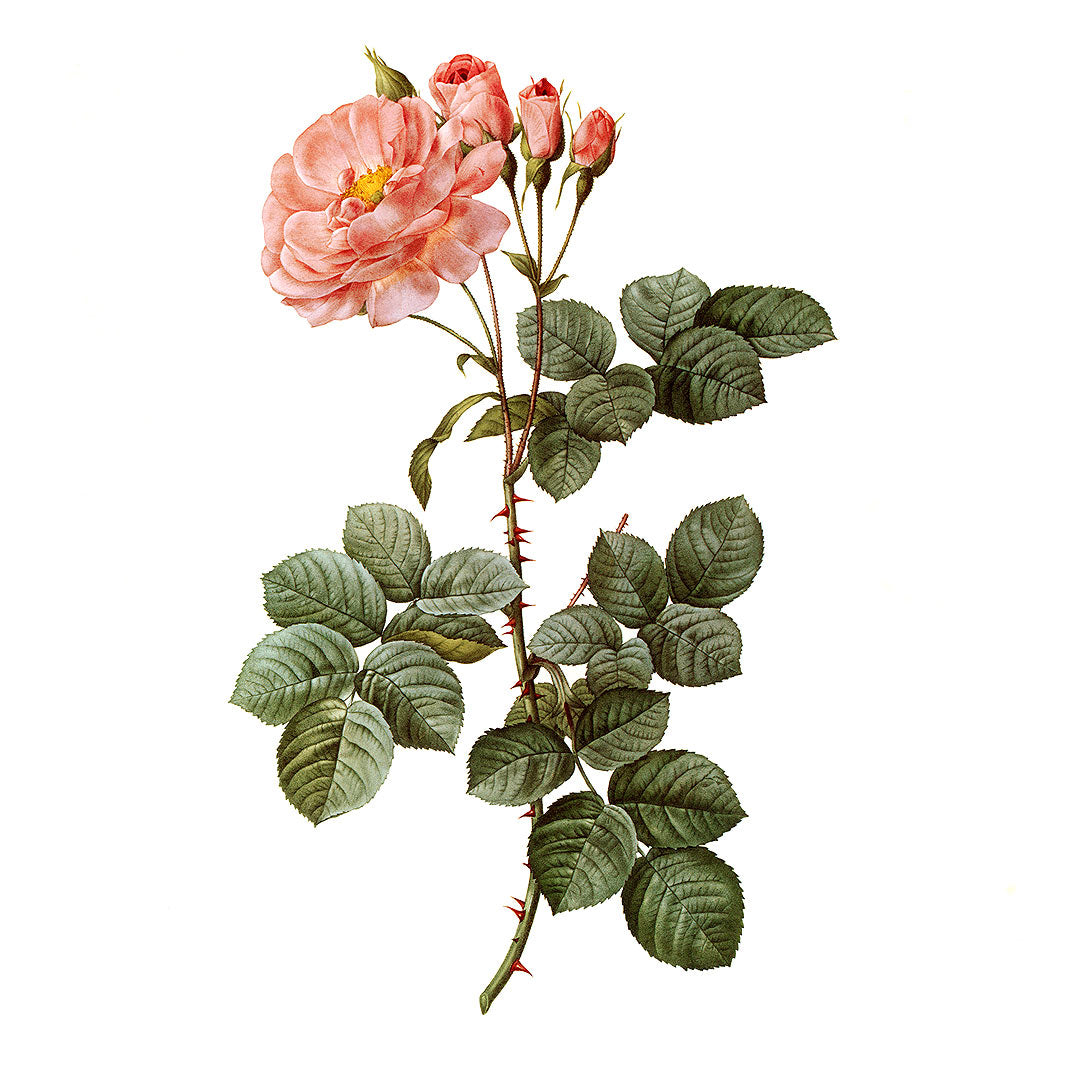
Rose
Rosa damascena
Common Name: Rose
Arabic name: ورد جوري
TCM Name: Mei gui hua (R. rugosa)
Ayurvedic Name: Satapatri or gulab ka phool
Family: Rosaceae
Parts Used: Flowers, fruit (rose hips)
Actions: Analgesic, Anti-inflammatory, Antioxidant, Antiseptic, Astringent, Reproductive tonic, Restorative, Vulnerary
Taste: Sweet (flower & hip), Sour (hip), Mild astringent (flower & hip), Bitter (flower), Pungent (flower)
Energy: Cooling, Contracting, Warming (in some herbal traditions)
Native To: The cultivated rose is supposed by some to have originated in ancient Persia. Today, the Rosa genus is considered native to the temperate and subtropical regions of the Northern Hemisphere.
Geographic Distribution: In addition to their native range of much of the Northern Hemisphere, Rosa species can be found in parts of Australia, Africa, and South America.
Botanical Description: Rose is a deciduous climbing or shrub-like perennial. Its stems are usually thorny to protect against predators, and the thorns are also useful in determining a species as they vary in color, size, and shape. Flowers have five sepals and at least one five-petal layer. These sepals serve as an exterior protection for the reproductive organs until they are mature, and the five petals work as an interior covering; at maturation, there is an unfurling to allow fertilization. Flowers come in a range of colors, although most herbalists today use red and pink varieties. The fruit of the rose, often referred to as the rose hip, is also useful for identification as the hips also vary in color, shape, and size.
History and folklore: A longtime symbol of love and beauty, the Rosa genus boasts over 100 species and more than 18,000 cultivars (Boskabady et al., 2011) growing throughout Asia, Europe, North America, and northern Africa. Although most commonly known today for its prominent role in aromatherapy, both rose blossoms and hips have been used in herbal traditions around the world for many thousands of years.
Rose has been widely valued for its aromatic properties since antiquity. While rose water is said to have been first prepared in the 10th century by the Persian physician Ibn Sina.
Uses: Much of the research on different rose species is still in the preclinical phase, with Rosa damascena appearing to receive the most interest among investigators. R. damascena has undergone preclinical studies to evaluate its action on everything from memory problems to gastrointestinal disorders. Its reported pharmacological effects include “antibacterial, antioxidant, antitussive, hypnotic, antidiabetic, and relaxant effect on tracheal chains”.
Rose has also been used since ancient times as a vulnerary that promotes tissue repair. Rose is also valued today for its ability to act as a reproductive restorative, particularly in Chinese medicine, where it is used for hormonal imbalances, and to address menstrual cycles (delayed periods, dysmenorrhea, painful periods, and pelvic blood congestion).
Rose hips have a fairly similar profile to that of the blossoms in terms of use; they have been an important part of rose’s use in various herbal traditions and are particularly valued for boosting the immune system. Rose hips are high in vitamin C, for which reason they are popularly used today. Nearly 200% of the recommended daily value is found in just 1 ounce of wild rose hips; they are also a good source of vitamin A, manganese, calcium, and magnesium.
Safety: Rose is generally deemed very safe. Due to their tannin content, rose petals may reduce the intestinal absorption of iron and alkaloids; caution is advised in cases of iron deficiency and for those taking pharmaceuticals containing alkaloids.
Back to top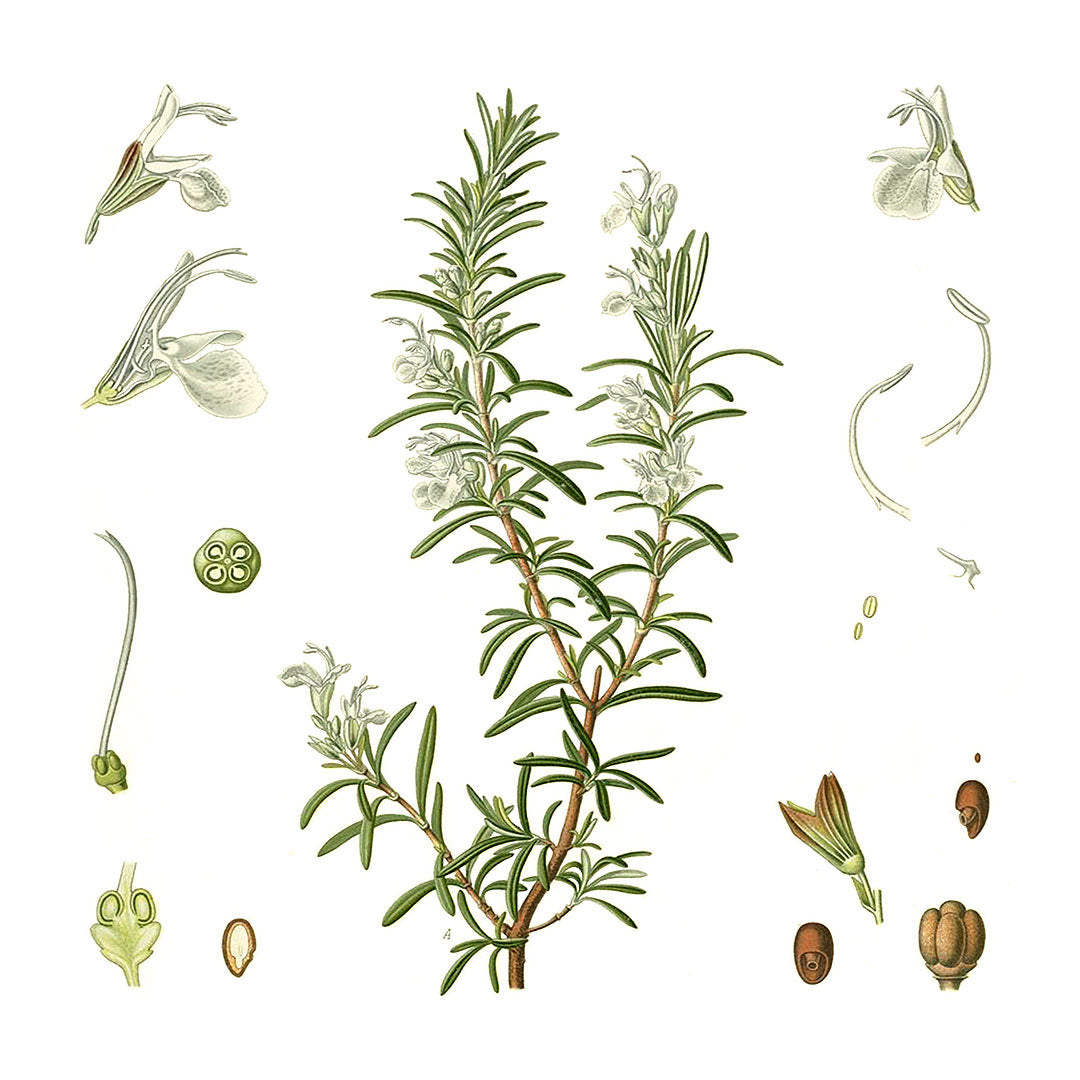
Rosemary
Salvia rosmarinus (syn. Rosmarinus officinalis)
Common Name: Rosemary, Polar Plant, Compass Weed, Compass Plant, Rosmarinus coronarium, Dew of the Sea, Garden Rosemary, Incensier, Mary’s Mantle
Arabic name: إكليل الجبل
TCM Name: Mi-tieh-hsiang
Ayurvedic Name: Rusmari
Family: Mint
Parts Used: Aerial parts
Actions: Circulatory Stimulant, Antidepressant, Anxiolytic, Nervine, Antispasmodic, Cholagogue, Carminative, Antibacterial, Anticancer, Antimicrobial, Anti-fungal, Antiseptic, Antioxidant, Anti-inflammatory, Emmenagogue
Taste: Pungent, Slightly sweet, Bitter (mild)
Energy: Warming, Drying, Stimulating, Restorative
Native To: Mediterranean region
Geographic Distribution: Cultivated worldwide in warm climates.
Botanical Description: Rosemary is a warm climate perennial shrub with both erect and creeping, prostrate cultivars, with the erect cultivars growing from two feet up to six feet tall. The needle-like dark green, lanceolate, leathery leaves are arranged in opposite pairs. The stem is square and becomes dark gray, scaly, and woody as it grows. The leaves are 1/2 to 1 inches long, glossy on the top, and covered with a grayish white downy fuzz on the underside. Small blue, pink or white flowers arranged in whorls around the stem bloom from May to July in warm climates, and later or not at all in colder climates.
Uses: Rosemary is a superb tonic for the memory, increasing mental function and acuity by increasing blood flow to and stimulating the brain (Berger, 1998). This stimulating action also has other benefits to the brain, as well, and rosemary is known as a folk remedy for anxiety, depression, insomnia, lethargy, nervousness, fatigue, exhaustion, stress, headaches, and migraines. In the heart, rosemary is both restorative and stimulating as a cardiotonic and warming arterial stimulant. Rosemary’s nervine effects are also felt in the heart, which is inextricably linked to the nervous system, relaxing and uplifting the spirit, bringing joy, and restoring the nervous system. This explains its use as an antidepressant. Rosemary is a well-known digestive tonic, antispasmodic, carminative, and cholagogue. It helps to relax and tone the stomach and is especially good for digestive upset resulting from mental tension, anxiety, and worry due to its nervine action. As a cholagogue, rosemary stimulates the production of bile and its flow from the liver, thus stimulating digestion and aiding in detoxification. As a carminative, it relieves gas and flatulent dyspepsia. Another stimulating effect of rosemary is its action as an emmenagogue to bring on menstruation through stimulation of blood flow to the pelvic region.
While raspberry leaf receives the most attention for its tonic effect on the womb, it is considered a general reproductive, genitourinary, and endocrine tonic for people of all genders. The herb is thought to strengthen the endocrine system and balance hormones; it is used to establish rhythm and regulate menstrual cycles in young people as well as restore irregular menstrual cycles.
Raspberry leaf is also widely used during pregnancy to strengthen the uterus and prepare the body for labor, a use which was originally introduced by Indigenous peoples of North America.
Today, it is one of the most commonly used herbs during pregnancy. It is considered an excellent tonic during pregnancy on two counts: its high vitamin and mineral content is richly nutritive for both parent and child, and its tonic properties help to strengthen the uterus in preparation for childbirth.
Raspberry leaf is a rich source of vitamins A, B, C, and E and minerals such as calcium, iron, phosphorus, potassium, magnesium, selenium, and manganese. It can be used as a nutritive tonic for low energy levels and during recovery from illness. When used as a nutritive tonic, raspberry leaf is often prepared as an infusion.
The leaf is particularly high in manganese, containing twice the amount of most herbs; manganese contributes to antioxidant actions in the body and supports bone health, wound healing, blood sugar regulation, and metabolism of nutrients. The herb is also a rich source of iron and is sometimes used to replenish iron-poor blood; it is often combined with nettle (Urtica dioica) leaf for this purpose.
Raspberry leaf also has antioxidant properties, which are attributed to the herb’s phenolic content. Researchers suggest that raspberry leaf’s high antioxidant activity, combined with its rich nutrient content, has the potential to guard against a variety of degenerative diseases such as diabetes, cancer, and atherosclerosis.
Safety: Pregnant and breastfeeding women may use rosemary in the amount used for culinary flavoring, but should not drink the tea or use the essential oil.
Back to top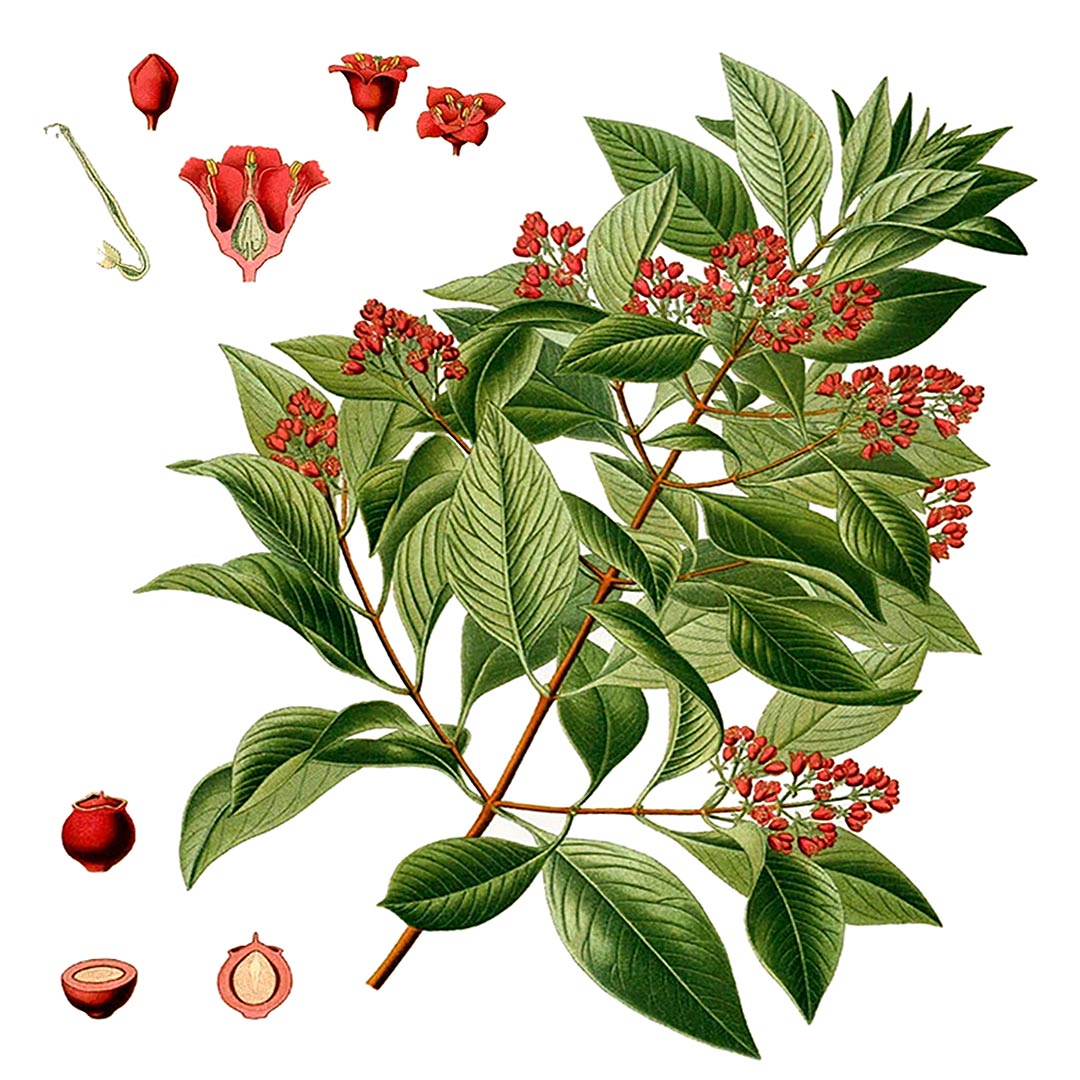
Sandalwood
Santalum album, Santalum spicatum
Common Name: Sandalwood, East Indian sandalwood, White sandalwood, White saunders
Family: Santalaceae
Parts Used: Heartwood, roots
Native To: Native to Ceylon, India, Indonesia, and their surrounding islands, S. album grows wild on Celebes and on the Portuguese island of Timor.
Geographic Distribution: South and Southeast Asia, southern China, and Taiwan, widely cultivated across India, Sri Lanka, and other parts of the world.
Botanical Description: The two main species used to produce sandalwood oil are Santalum album (East Indian sandalwood) and S. spicatum (Australian sandalwood). S.album is a small evergreen tree that grows to 30 feet.1 With fragrant wood and ovate leaves, the tree has dull yellow to maroon flowers followed by dark red to black fruits.
History and folklore: Arab apothecaries in eighth century Baghdad owned private drug stores in which Indian sandalwood was a commonly used herb. There are depictions, in Arabic writings and pictures, of apothecaries trading with traveling merchants for the precious sandalwood. In Chinese medicine, East Indian sandalwood oil was used internally to treat stomachache and vomiting. The oil was also used in Europe for fevers, pains, and strengthening the heart.
History and folklore: Sandalwood has a 4,000-year history in spirituality, medicine, and perfumery, deeply rooted in Indian and Chinese cultures. It is considered sacred in many religions, used in rituals and to create religious carvings. In folklore, its sweet scent is thought to drive away evil spirits, and legends say snakes are bewitched by it. Sandalwood was used by ancient Egyptians for embalming and in rituals. Introduced to Europe via the Arabs, it became a popular ingredient in modern perfumery, especially for men's colognes, in the 19th century.
Uses: Treating issues like colds, bronchitis, and skin disorders in the ancient Chinese and Ayurvedic medicine.
Back to top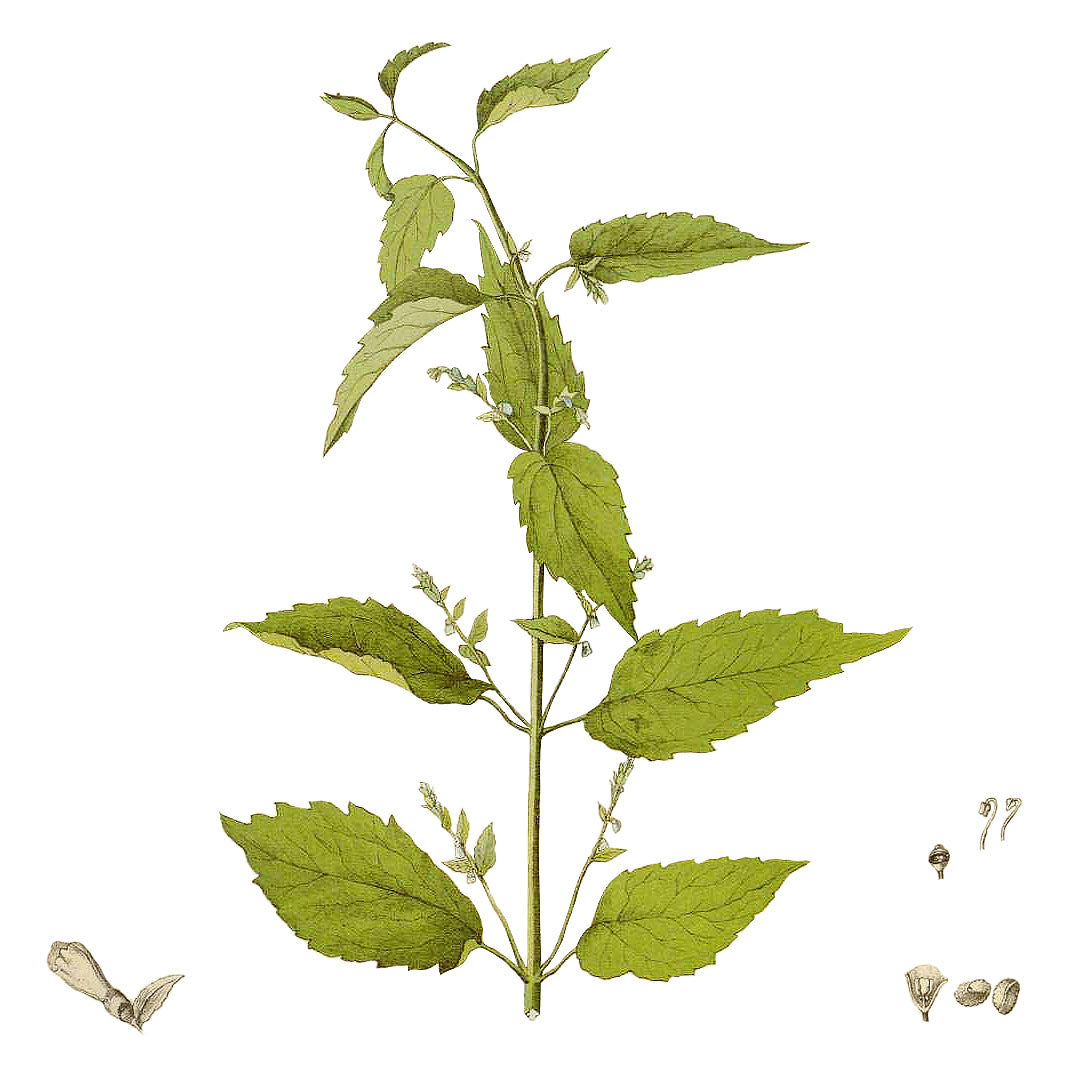
Skullcap
Scutellaria lateriflora
Common Name: Skullcap, blue skullcap, mad-dog skullcap, madweed, hoodwort, helmet flower, blue pimpernel, hooded willow herb
Family: Lamiaceae
Parts Used: Leaf, flower, stems
Actions: Anxiolytic, Antispasmodic, Analgesic, Bitter, Hypotensive, Nervine, Relaxant, Trophorestorative
Taste: Bitter (mild), Earthy, Slightly sweet
Energy: Cooling, Drying
Native To: North America
History and folklore: Skullcap has nervine, anxiolytic, antispasmodic, digestive, hypotensive, and analgesic actions. The Cherokee have traditionally used skullcap as a sedative and antispasmodic to relax nervous tension; the herb also has a history of use among the Cherokee for easing breast pains and in formulas for stubborn respiratory conditions and bronchitis. The Delaware have used marsh skullcap (S. galericulata) plant tops as a digestive stimulant and laxative. According to an ethnobotanical source, the Ojibwa have traditionally used marsh skullcap for heart trouble, and the Mendocino have used California skullcap (Scutellaria californica) as a febrifuge for chills and fevers.
Uses: Skullcap is a soothing, relaxing nervine that is also grounding in the sense that it brings one into bodily presence. As a nervine, it is indicated when there is stuck life energy resulting from a constant state of stress and adrenaline rushes that leave one tense and exhausted, with the potential for heart palpitations.
As a relaxant, skullcap eases tension and aids its release. Skullcap nourishes and builds our nerves, easing the effects of chronic stress on our nervous system, and moves tension stored in our bodies. It builds, relaxes, and encourages flow. As such, skullcap is used for overcoming exhaustion or depression. Skullcap is also a nice tea or tincture for easing into sleep, calming nervous and restless energy, and inviting deep sleep and dreaming. It blends well with other nervines such as milky oat (Avena sativa), lemon balm (Melissa officinalis), chamomile (Matricaria chamomilla), and linden (Tilia spp.).
As do most members of the mint family, skullcap helps to stimulate appetite and ease indigestion, particularly in the case of appetite loss and gastric distress associated with nervous tension or stress (Holmes, 2006). This effect is attributed to skullcap’s antispasmodic and bitter actions, which help support the liver and relax digestive spasms, stimulate the production of bile to improve digestion and toxin removal, and cool heat from the digestive system.
Skullcap’s antispasmodic and nervine actions also make it an ally for premenstrual tension, dysmenorrhea (menstrual cramping), menorrhagia (heaving bleeding), menopause, and accompanying impacts to the nervous system such as irritability, depression, and anxiety.
Safety: Avoid use of skullcap during pregnancy and lactation due to a lack of studies confirming its safety. Skullcap products in the marketplace have a history of adulteration with germander, a hepatotoxic plant, so it is important to source skullcap from a reputable, trustworthy source. Skullcap can potentiate sedative medications, and overdose of the tincture may result in side effects such as stupor, confusion, giddiness, and twitching of limbs.
Back to top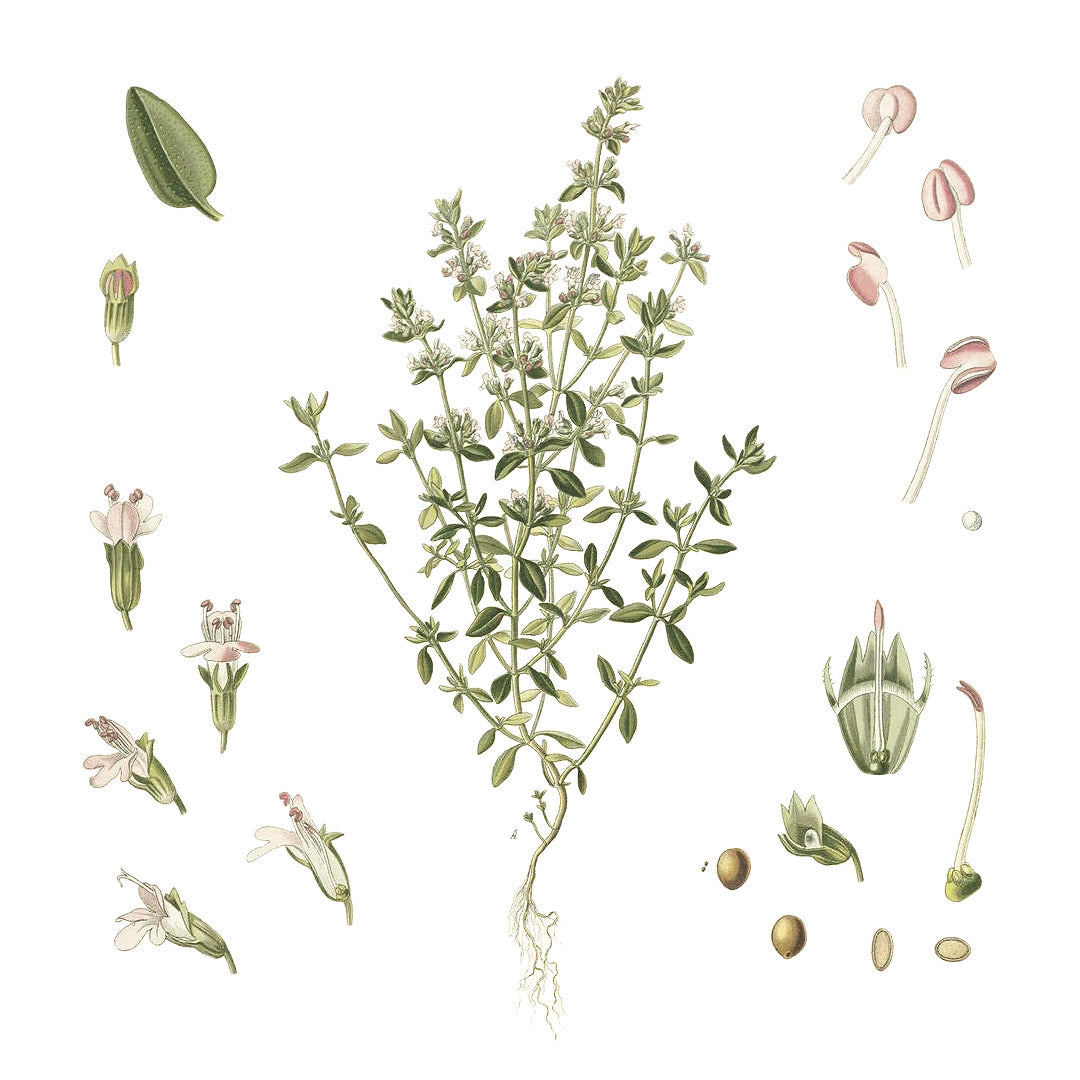
Thyme
Thymus vulgaris
Common Name: Thyme, garden thyme, common thyme, tomillo, rubbed thyme, English thyme, French thyme, German thyme, winter thyme, whooping cough herb
Arabic name: زعتر
TCM Name: Bai li xiang
Family: Lamiaceae
Parts Used: Aerial parts
Actions: Antiseptic, Antispasmodic, Antimicrobial, Antioxidant, Antiviral, Antibacterial, Astringent, Expectorant, Secretolitic, Spasmolytic, Nervine, Carminative, Stimulant, Emmenagogue, Diuretic, Thymoleptic, Anthelmintic
Taste: Aromatic, Bitter (mild), Earthy, Sweet, Minty
Energy: Calming, Drying, Warming, Soothing
Native To: France, Italy, Spain
Geographic Distribution: Thyme is widely cultivated all over the world in areas with temperate climates. Its current distribution includes countries close to its native Mediterranean range.
Botanical Description: Thyme is a low-growing shrub-like perennial with woody stalks and fibrous roots. It grows anywhere from 2-15 inches tall depending on variety. It grows in dense mats and has a strong and pleasant aroma. Small, pretty flowers arrive during summer in dense, terminal clusters. The flowers can range from pale pink, magenta, mauve, white, and blue-violet with the most common being a lilac color.
History and folklore: The name Thymus can be traced back to the botanical writings of Theophrastus, the Greek philosopher and naturalist of the 3rd century BCE (Bettler, 1997). Thymus comes from the Greek word θυμός (thymós), which historically held a variety of meanings, among them spirit, strength, courage, and anger or other passions. Thyme has had a strong role in the kitchen since antiquity, where it was employed as a culinary addition as well as an appetite stimulant (Pliny, 77/1906). The same goes for its application with respect to digestive issues that include stagnant digestion, flatulence, and heartburn. In the first century CE, Pliny (77/1906) listed thyme as specific to intestinal diseases.
Uses: Thyme is the common name for 300-400 different species that are currently cultivated around the world, the most common variety being Thymus vulgaris. A part of the Lamiaceae (mint) family, thyme is also a close relative of Origanum, the oregano genus.
Thyme possesses a range of applications in both Western and Eastern herbal traditions that have either been sustained to the present day or which are now being investigated and largely supported by science. Thyme was and is most frequently connected to respiratory and digestive systems. Besides its prominent association with these two major body systems, thyme is well known as a protector against infections. It is also worth exploring thyme’s historical herbal roles as a powerful aid to the nervous system, as an ally for menstrual and uterine health, as well as a few more minor traditional uses that are re-emerging from long-ago historical shadows.
Thyme has long been favored by herbalists as a go-to herb for breathing difficulties and for any kind of imbalance that encroaches upon the respiratory system. The primary chemical constituent of thyme, thymol, is expectorant, antispasmodic, and antimicrobial; this volatile oil plays a key role with respect to the lungs. In Chinese medicine, thyme is also intimately connected to the Lung meridian, where it is used to warm the lungs in instances of white phlegm, chills, fever, asthma, and tuberculosis, as well as for immune system support in the presence of colds. In addition, the herb has an opening influence upon the sinuses, where its warming and drying nature helps to clear congestion.
Thyme, which stimulates the thymus gland in the body, is furthermore viewed as a relaxant specific to the parasympathetic system, hence its use for disturbed sleep with low-level anxiety or nightmares, and for stimulating the adrenal cortex.
Safety: Thyme is generally considered safe to use and has no known side effects. There have been some reports of allergic reactions, including cross-sensitivity with rosemary (Salvia rosmarinus) and oregano (Origanum vulgare). Thyme’s essential oil can cause skin and mucous membrane irritation, as well as possible allergic reactions including headache, vomiting, and diarrhea. Since thyme has been linked with uterine stimulation, it should not be used during pregnancy.
Back to top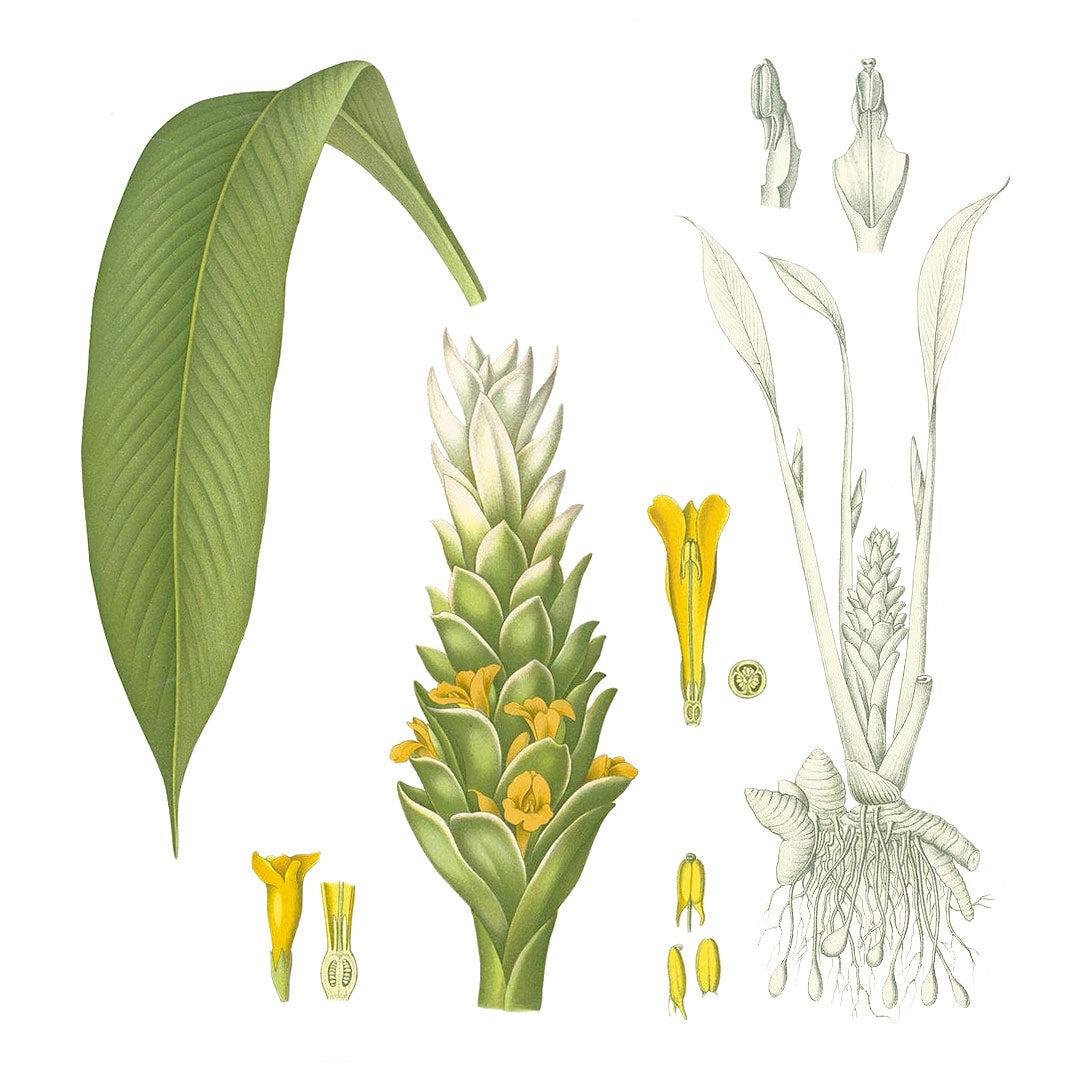
Turmeric
Curcuma longa
Common Name: Turmeric
TCM name: Jiang huang
Ayurvedic name: Haridra, haldi, aushadhi, gouri, kanchani, and about 40 other names
Family: Zingiberaceae
Parts Used: Rhizome
Actions: Alterative, Anti-inflammatory, Antimicrobial, Antioxidant, Cholagogue, Choleretic, Hepatoprotective, Hypolipidemic, Vulnerary
Taste: Astringent, Bitter, Pungent
Energy: Warming, Slightly drying
Native To: South Asia
Geographic Distribution: India and Southeast Asia
Botanical Description: Turmeric is an herbaceous perennial that grows to just over 1 meter tall, with green elliptic to lanceolate leaves that are 3.5 inches long. The pale yellow flowers appear in short dense spikes. The root system consists of the bright orange, thick rhizomes that are generally 2.5-7.5 cm in length by 1-2 cm in diameter.
Uses: Turmeric is a choleretic, cholagogue, hepatoprotective, anti-inflammatory, hypolipidemic, antimicrobial, and antioxidant herb. Most modern Westerners consider turmeric an anti-inflammatory agent, and indeed, traditionally this root is often used in an ayurvedic approach to soothe inflammation of the throat and tonsils, and as an anti-inflammatory herb for many other aches and pains including muscle aches, back pain, cramping, and joint pain.
Because it has been found that turmeric is rapidly metabolized by the liver and intestines, its beneficial properties may not be as effective unless it is consumed with black pepper, which has been found to enhance the bioavailability of the curcumin in turmeric by 2000%.
In Western herbalism, turmeric is used as a choleretic to stimulate production of bile, thereby supporting digestion; likewise, in Ayurveda, turmeric is a warming herb that kindles digestive fire, or agni. Like other bitter herbs that stimulate bile production, turmeric can help promote digestion and ease gastrointestinal issues. Turmeric is also a cholagogue, meaning it helps promote flow of bile.
Along with its ability to stimulate bile production in the liver, turmeric is also hepatoprotective (liver protectant).
Curcumin has been studied extensively for its potential anticancer action, including its ability to inhibit cell growth and metastases. The consumption of turmeric is correlated epidemiologically with lower rates of cancer, including breast, prostate, lung, and colon cancers. Curcumin may also help protect against Alzheimer's disease, because it triggers a gene that codes antioxidant production which helps protect the brain from oxidative damage.
Safety: Turmeric eaten in food is considered safe. For some individuals, turmeric should not be used at high doses long term, as overuse may cause gastrointestinal disturbances in some susceptible people. Turmeric is considered contraindicated in the case of biliary tract obstruction due to potential bile-stimulating activity, and those with a history of biliary tract obstruction should seek professional advice before using turmeric.
Because turmeric may have antiplatelet and blood-thinning activity, individuals on blood-thinning medications should exercise caution when considering use and speak with their healthcare professional or pharmacist prior to self administration. For similar reasons, it is also generally advised that individuals undergoing surgery stop consuming therapeutic doses of turmeric at least 2 weeks prior to their procedure.
Eating foods with turmeric during pregnancy is generally considered safe; however, turmeric should not be taken in high doses by pregnant women due to its potential emmenagogue effects.
Lastly, one small study concluded that consumption of supplemental doses of turmeric can significantly increase urinary oxalate excretion which may subsequently increase risk of kidney stone formation in susceptible individuals.
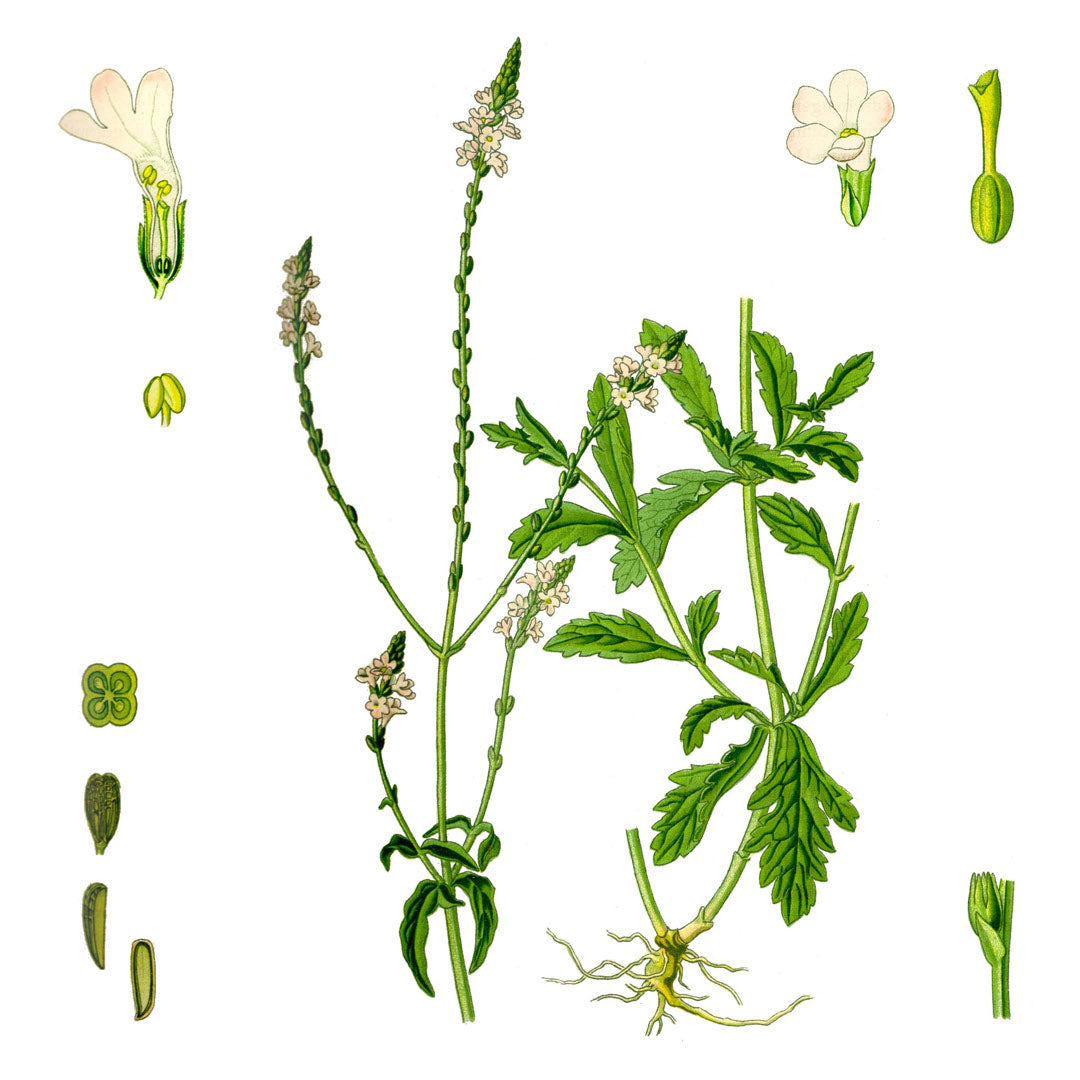
Vervain
Verbena officinalis
Common Name: Vervain, berbine, common vervain, herba sacra, verbena
TCM name: Ma Bian Cao
Parts Used: Aerial parts, root
Actions: Alterative, Anti-inflammatory, Antibacterial, Antimicrobial, Antispasmodic, Astringent, Diaphoretic, Diuretic, Emmenagogue, Galactogogue, Hepatic, Nervine, Trophorestorative, Vulnerary, Analgesic, Anticonvulsant, Uterine stimulant
Taste: Bitter, Astringent
Energy: Cold, Drying
Native To: Europe, Western Asia, and North Africa
Geographic Distribution: Its distribution may be classified as Eurasian Southern-temperate, but vervain is widely naturalized outside of that category, having been introduced not just into Ireland, but also Australasia and North America.
Botanical Description: Vervain is a perennial plant that possesses medium to dark green opposite leaves with toothed lobes. It generally grows to between about 1-2 feet in height. Its five-petaled flowers, perched in spike formation, are tiny and pale lavender in color, often with whitish centers. As they bloom, the flowers become more distantly spaced from one another.
History and folklore: While Verbena officinalis (European vervain) is largely portrayed today in Western herbal practices as a nervine, this gentle herb is historically extremely wide ranging in application. Since antiquity, vervain has also notably been linked to magical practices and considered a heal-all.
Uses: Vervain may be used in both Eastern and Western traditions as a wide-spectrum herb that brings the body into balance; it is excellent for addressing chronic, complex conditions (Holmes, 2007) and is therefore seen as a tonic, one which may cleanse the blood, so to speak.
Vervain has been used over many centuries as a vulnerary, in which its astringent, anti-inflammatory, and antimicrobial actions appear to have been key. The antimicrobial aspects of vervain have perhaps received the rest of the bulk of current scientific scrutiny. Whole leaf and root methanol extracts of vervain showed antimicrobial activity against several bacterial strains, with the leaf extract effective against Staphylococcus aureus, Shigella boydii, and Streptococcus pneumoniae and more effective at inhibiting growth than the root extract. Vervain was also used for pain management.
Safety: Vervain is often confused with lemon verbena (Aloysia triphylla), known as vervaine in France, and which is not interchangeable with V. officinalis, V. hastata, or other species of the verbena family.
Vervain is a uterine stimulant and as such is contraindicated in pregnancy by many herbalists. It is also speculatively suggested that it not be used specifically in early pregnancy due to the herb’s emmenagogic nature.
It has been suggested that vervain not be imbibed by vegans and vegetarians with meals; its phenylpropanoids may interfere with non-heme iron absorption.
